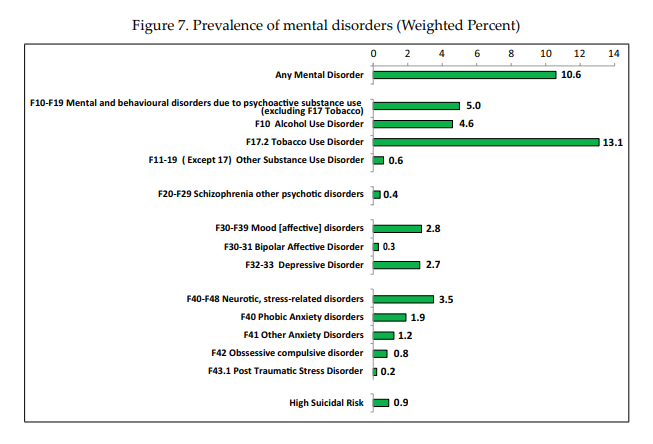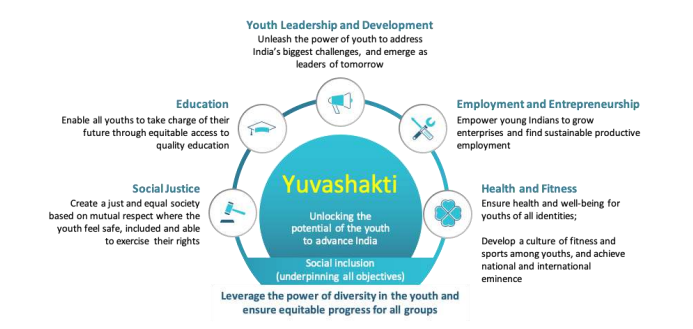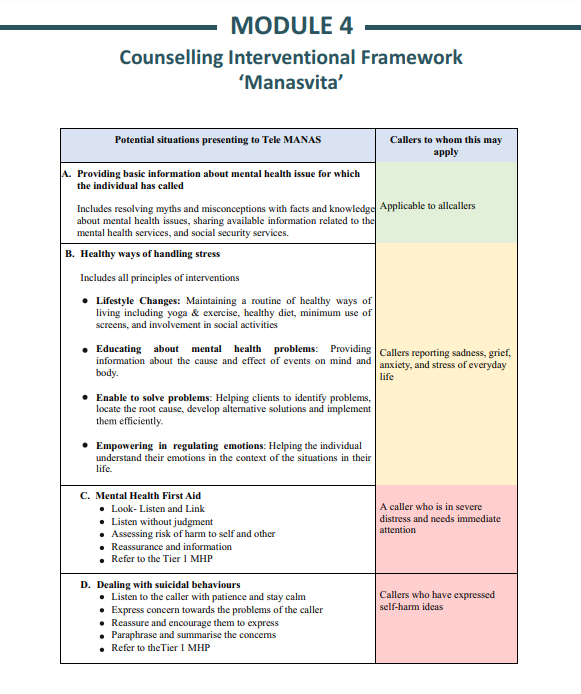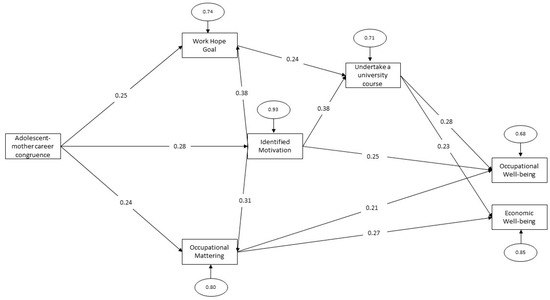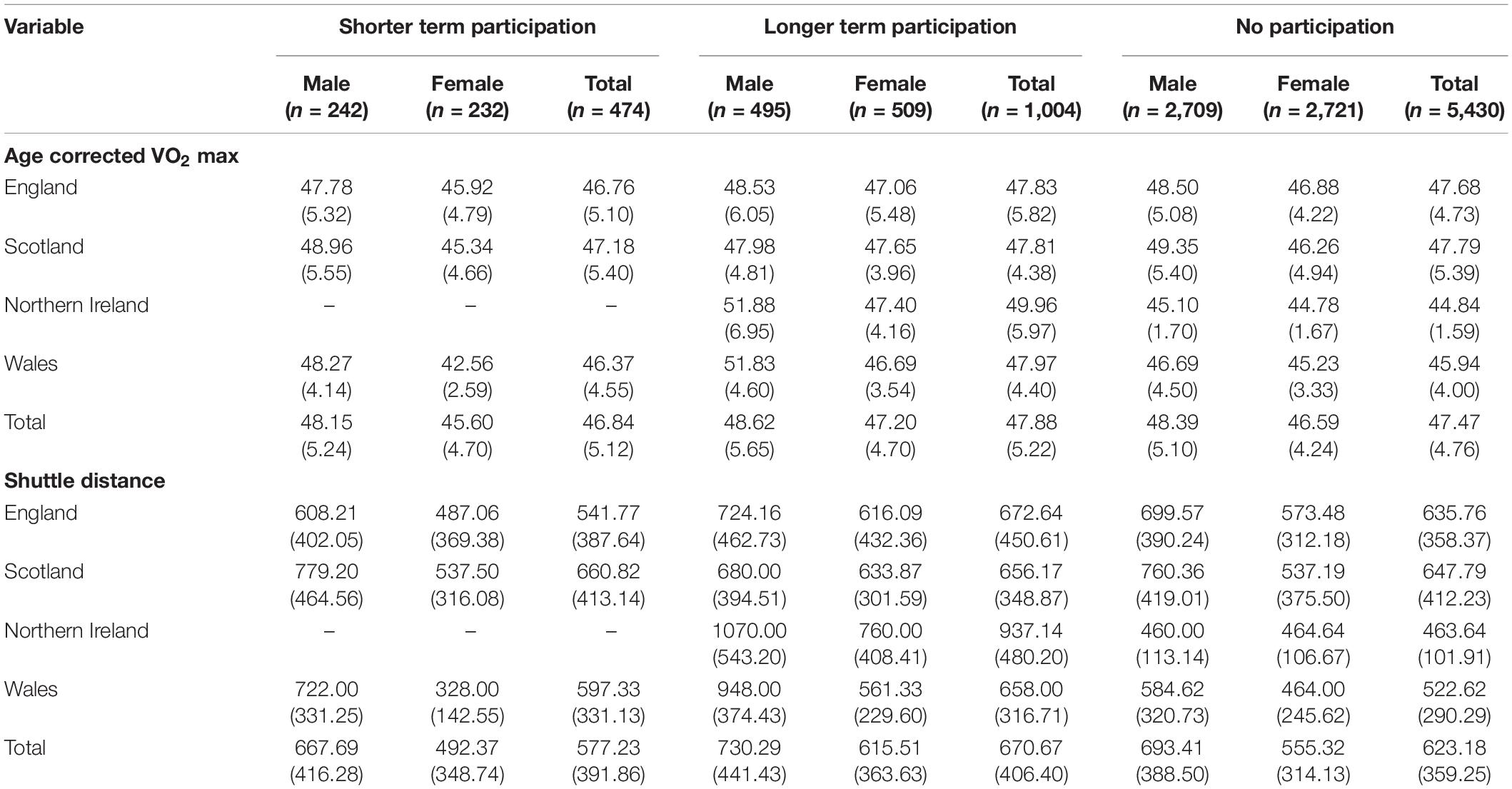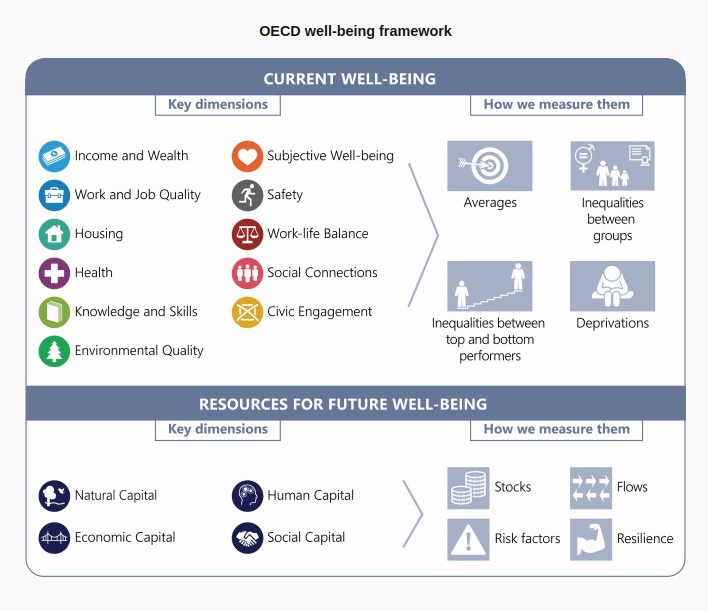
Measuring Well-being and Progress: Well-being Research
The OECD Framework for Measuring Well-Being and Progress shown below is based on the recommendations made in 2009 by the Commission on the Measurement of Economic Performance and Social Progress to which the OECD contributed significantly. It also reflects earlier OECD work and various national initiatives in the field. This Framework is built around three distinct components: current well-being, inequalities in well-being outcomes, and resources for future well-being.
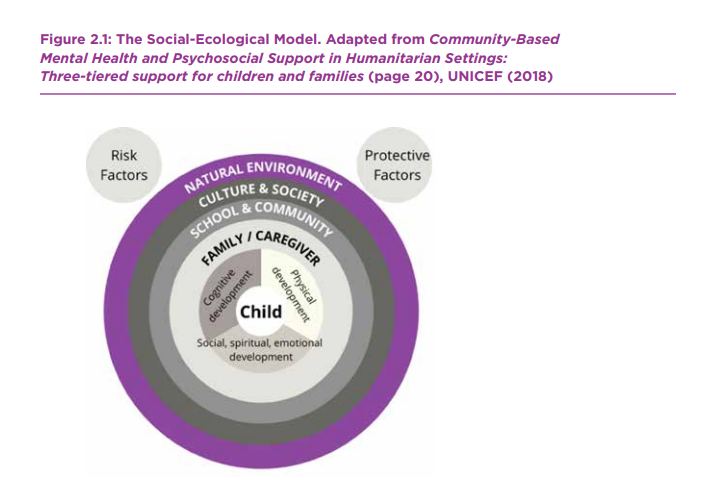
Happiness Council
Governments can help citizens with treatment and strategy through policies and help deliver options to all population levels, including the vulnerable. Technology also has a crucial role in improving resilience, but only when cooperating with organizations, regulations, structures, and other stakeholders. The briefs explore vulnerabilities and sources of
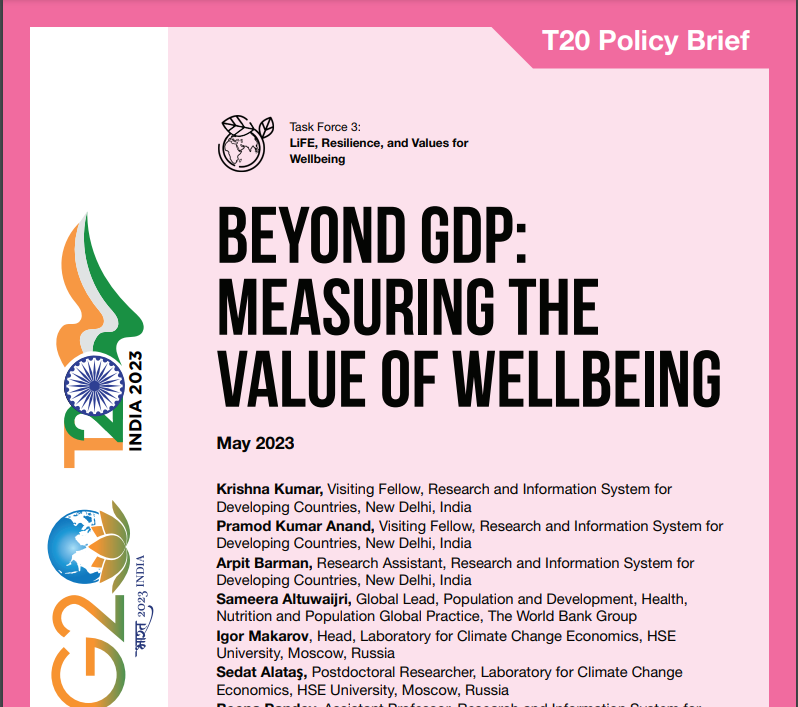
Beyond GDP Measureing the value of well-being
Incorporating wellbeing measurement indicators with GDP in policymaking can help the G20 enhance allocative efficiency, as well as provide a comprehensive understanding of the social and economic factors that influence quality of life by appropriately valuing wellbeing. It will help the G20 move towards a more holistic and sustainable approach to economic.

India’s mental health conversation is opening up. Better access to treatment is the next frontier
The study also revealed a dramatic shift in the general perception of people with mental illness with 65% – more than double the 32% from 2018 – believing that such individuals could hold jobs and lead stable, healthy lives. Another 68% maintained that people with mental illness could form meaningful relationships with friends, family and companions, which is a heartening change in a country where the mental health sector is rife with misinformation. Read more….
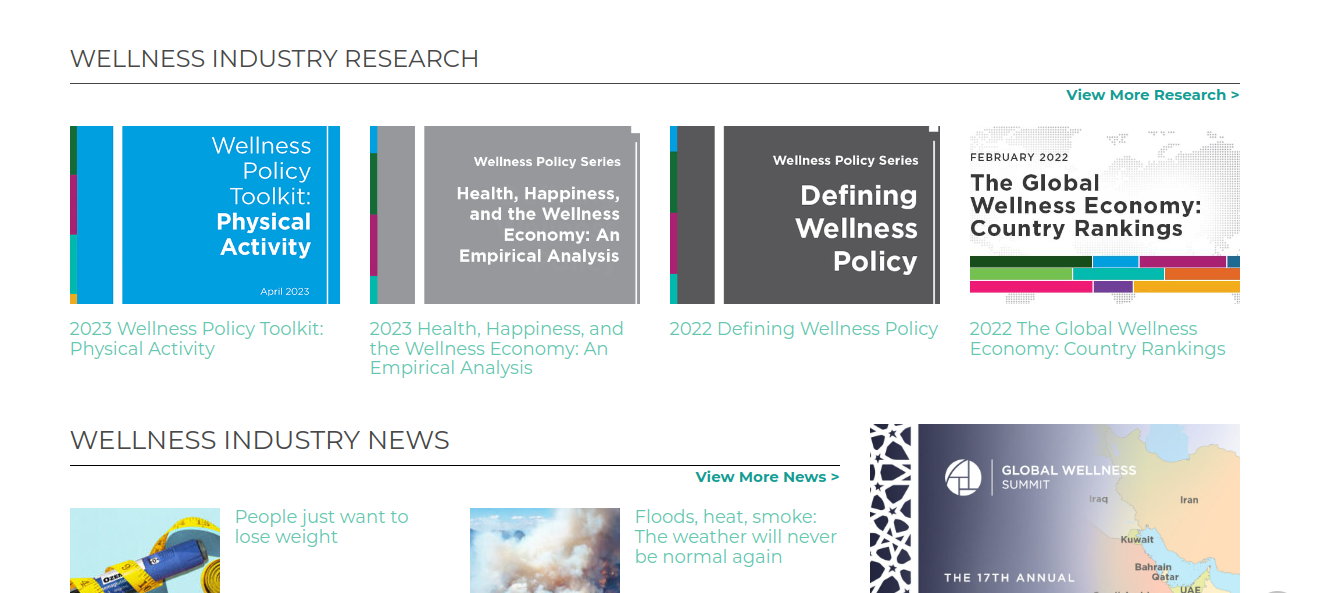
HAPPINESS AND WELLBEING INDICES
The Global Wellness Institute (GWI) is a 501(c)(3) nonprofit organization with a mission to empower wellness worldwide by educating the public and private sectors about preventative health and wellness. GWI’s research, programs and initiatives have been instrumental in the growth of the USD $4.4 trillion wellness economy—and in uniting the health and wellness industries.Through its five pillars—Research, Initiatives, Roundtable Discussions, wellnessevidence.com and The Wellness Moonshot: A World Free of Preventable Disease—the GWI informs and connects key stakeholders capable of impacting the overall wellbeing of our planet and its citizens.
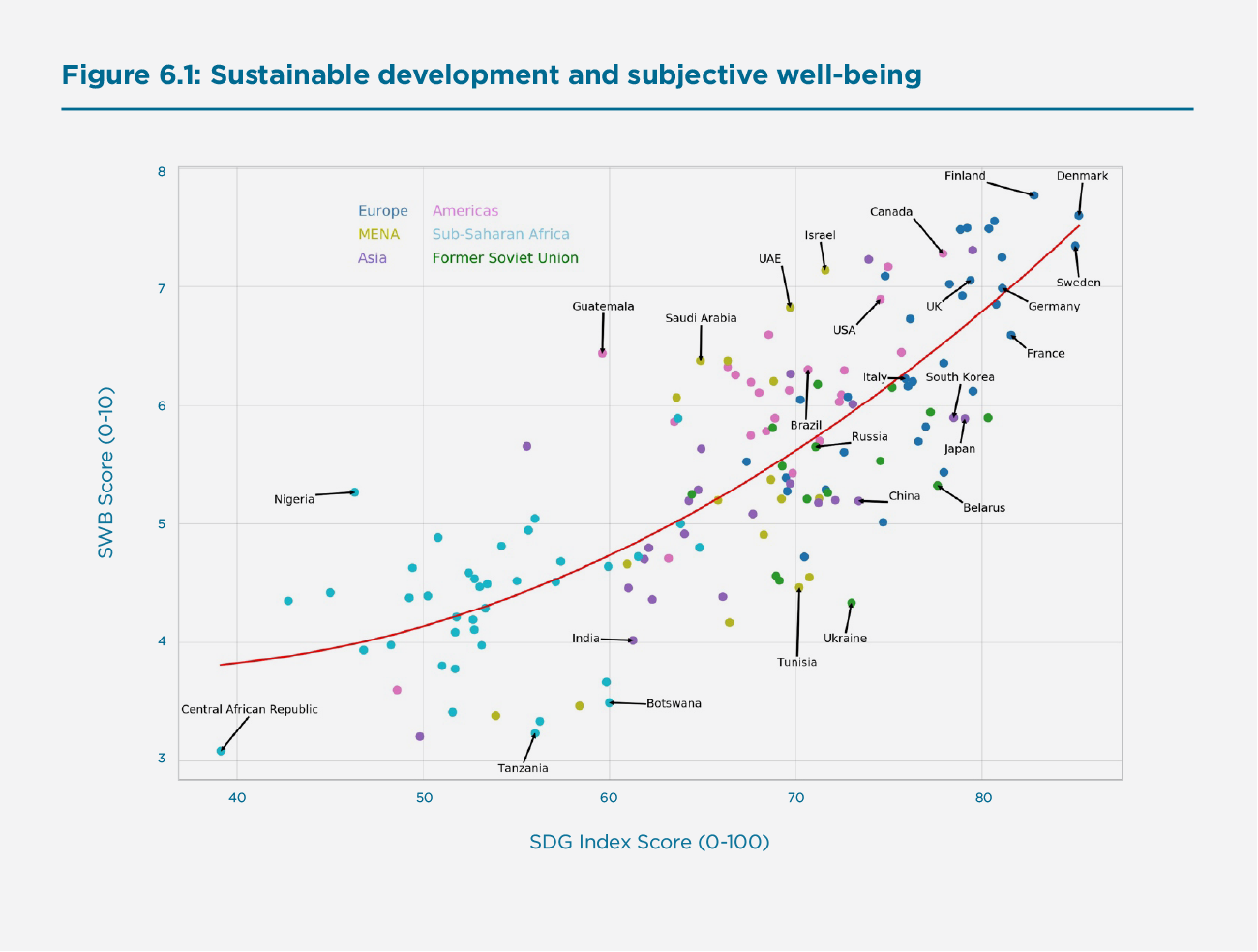
Sustainable Development and Human Well-Being
The World Happiness Report is a publication of the Sustainable Development Solutions Network, powered by the Gallup World Poll data. The World Happiness Report reflects a worldwide demand for more attention to happiness and well-being as criteria for government policy. It reviews the state of happiness in the world today and shows how the science of happiness Read more…
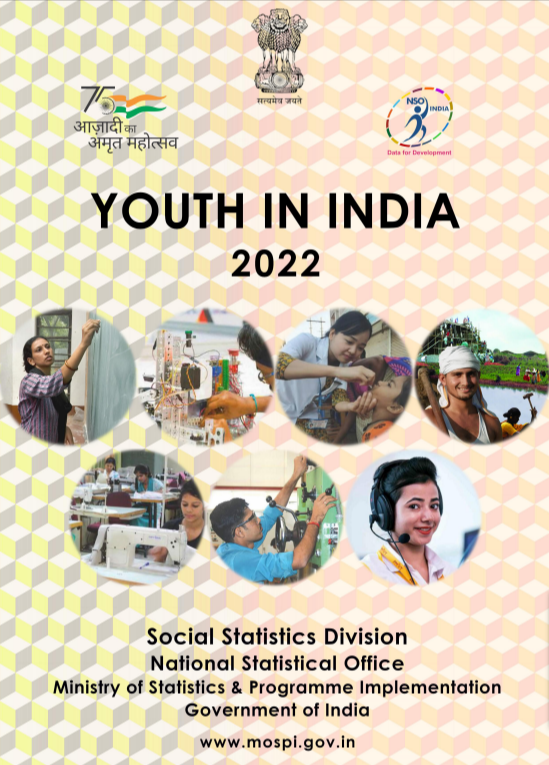
Youth in India 2022
This publication provides diverse profile and status of youth at state and central level for various indicators of socio-economic relevance as derived from published official data for accessing youth statistics by the users, such as education, employment, entrepreneurship, health, sports, social values, community engagement etc.
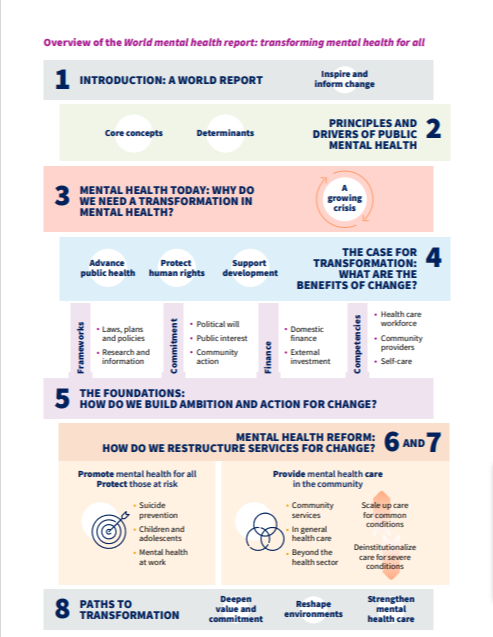
World Mental Health Report: Transforming Mental Health for All
The world mental health report highlights the need for change in mental health systems. This report is designed to inspire and inform the indisputable and urgent transformation required to ensure better mental health for all. While promoting a multisectoral approach, this report is especially written for decision-makers in the health sector.
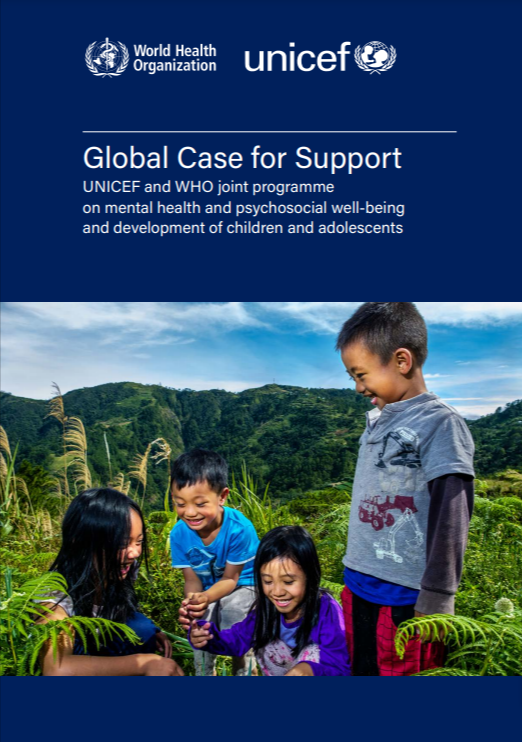
UNICEF and WHO Joint Programme on Mental Health and Psychosocial Well-being and Development of Children and Adolescents
The UNICEF and WHO Joint Programme on Mental Health and Psychosocial Well-being and Development of Children and Adolescents is an ambitious, 10-year action plan to realize a bold vision for children, adolescents, and their caregivers. The joint programme is designed to provide succinct and relevant information on mental health and psychosocial well-being.
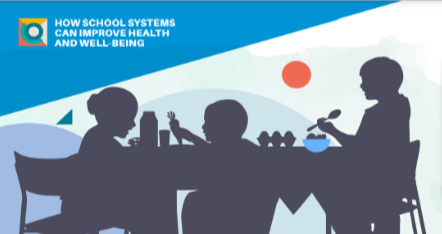
How School Systems Can Improve Health and Well-being: Topic Briefs: Nutrition
This topic brief highlights how nutrition and healthy diets support the achievement of education and learning objectives, and explains how intervention benefits can be amplified with a whole-school and systems approach. The recommended actions are informed by the Global Standards for health-promoting schools.
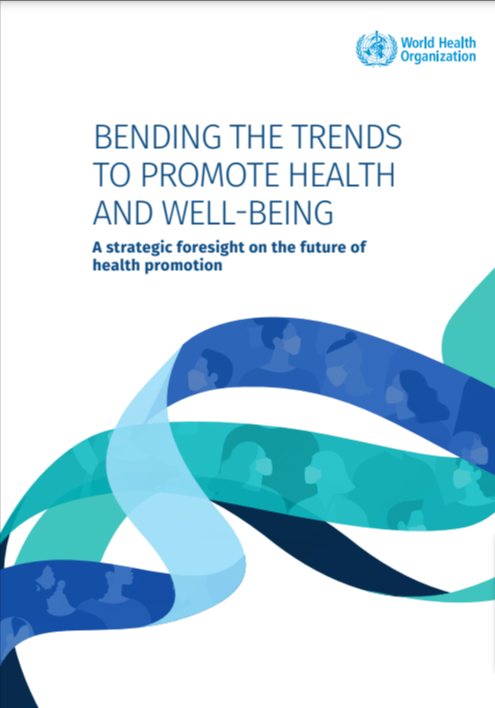
Bending the Trends to Promote Health and Well-being: A Strategic Foresight on the Future of Health Promotion
This strategic foresight aims to inform future planning of the WHO in support of SDGs and enhanced wellbeing. It provides an analysis of health promotion system capacity models and horizon-scanning of global trends, emphasizing the need for investment in health promotion as a mindset and practice.
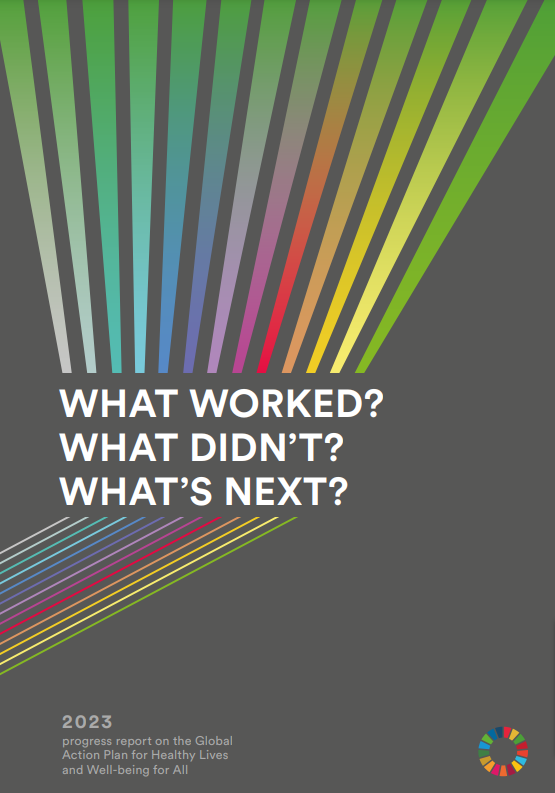
What Worked, What Didn’t, What Next
The publication is 2023 progress report provides an overview of what worked, what didn’t and what’s next in the global action plan for healthy lives and wellbeing for all by WHO. It is a comprehensive report that covers various aspects of health care such as primary health care, healthy lifestyle, global health, health priorities, health policy, social determinants of health and community participation.
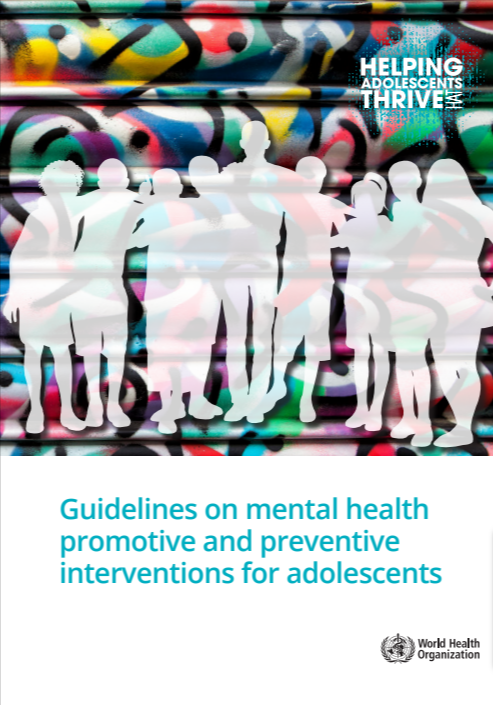
Guidelines on Mental Health Promotive and Preventive Interventions for adolescent
The guidelines on promotive and preventive mental health interventions for adolescents- helping adolescents thrive (HAT), provide evidence-informed recommendations on psychosocial interventions to promote mental health, prevent mental disorders ad reduce self-harm and other risk behaviors among adolescents.
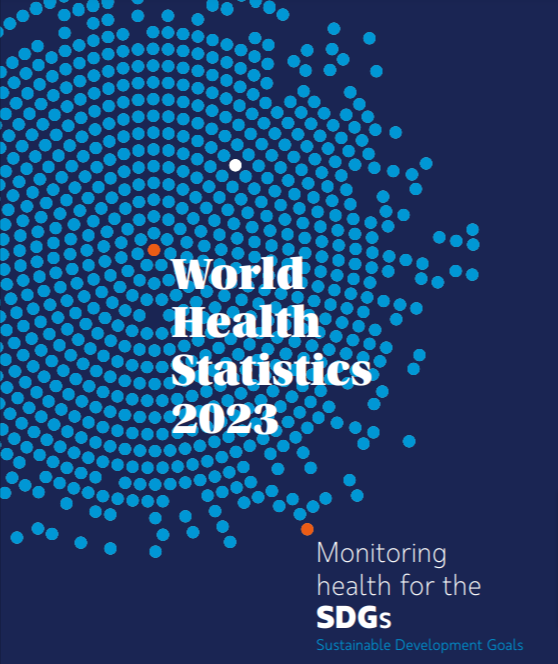
World Health Statistics 2023: Monitoring Health for SDGs
The World Health Statistics report reviews more than 50 health-related indicators from the Sustainable Development Goals (SDGs) and WHO’s 13th General Programme of work (GPW 13). It discusses the key issues and trends in global health, summary status of the health-related SDGs and GPW 13 indicators and future preparations for the next stage of global health.
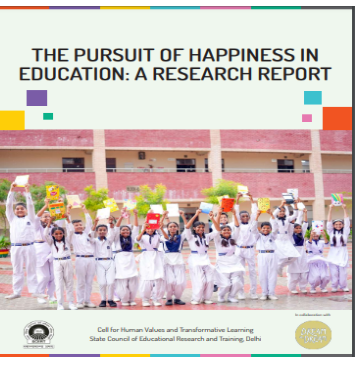
A research report on the pursuit of happiness in education
The Delhi SCERT’s research on happiness in education underscores the significance of integrating social and emotional learning into the curriculum. It emphasizes that fostering mindfulness, self-awareness, critical thinking, reflection, and interpersonal relations can greatly
enhance students’ happiness and well-being. This approach is designed to cultivate a more holistic educational experience that supports not only academic success but also personal growth and emotional health.
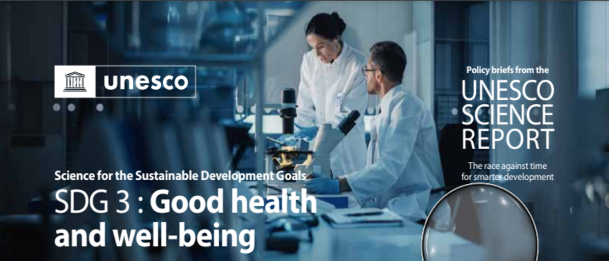
UNESCO Science Report on Good Health and Well-being (SDG 3)
The UNESCO policy brief on SDG 3 emphasizes the vital role of science in promoting health and well-being. It highlights the critical role of scientific advancements in improving health outcomes and achieving the Sustainable Development Goals. The brief advocates for improved healthcare systems, increased funding for health research, and the use of data-driven policies to enhance public health outcomes globally, particularly in addressing mental health challenges and promoting overall well-being.
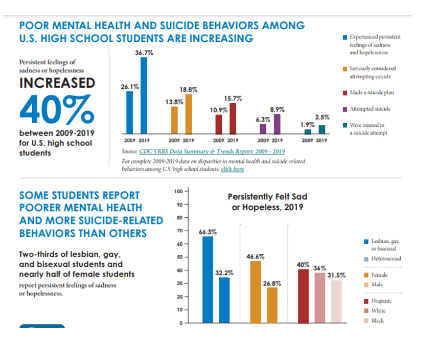
CDC's Fact Sheet on Mental Health Among Adolescents
The CDC fact sheet on adolescent mental health reveals that a significant number of youth face mental health challenges such as stress, anxiety, and depression, impacting their academic and overall well-being. It emphasizes the need for school-based mental health services and supportive environments to address these issues effectively, advocating for comprehensive approaches to enhance the mental health and well-being of young people.
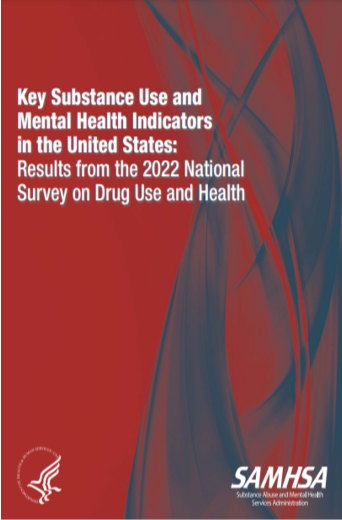
Key Substance Use and Mental Health Indicators in the United States 2022
The 2022 National Survey on Drug Use and Health (NSDUH) highlights the prevalence of mental health and substance use disorders in the United States. It reports significant rates of mental illness, particularly among young adults, and underscores the critical need for accessible mental health services. The survey also discusses the impact of the COVID-19 pandemic on mental health and substance use trends, emphasizing the importance of integrated care and support systems to improve overall well-being.
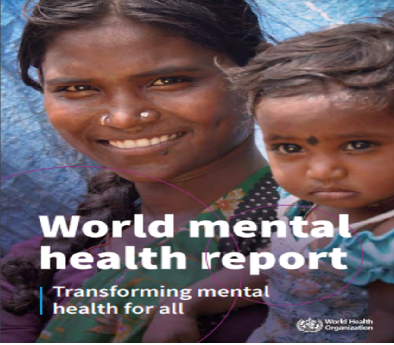
WHO’s World Mental Report
The WHO World Mental Health Report highlights the critical importance of mental health globally, emphasizing the high prevalence of mental health needs and the inadequate responses to these needs. It reveals that nearly a billion people, including 14% of adolescents, live with mental disorders. The report calls for a transformation in mental health care, focusing on reshaping attitudes, improving environments that influence mental health, and strengthening mental health systems. This comprehensive review aims to inspire collective action to enhance mental health support worldwide.

NATIONAL MENTAL HEALTH PROGRAMME (NMHP)
From a public health perspective, the prevalence, pattern, characteristics and determinants of various mental disorders have been examined. In addition, care related issues like service delivery aspects and system issues have also been studied.
In this emerging scenario, mental, neurological and substance use disorders (MNSUDs), included under the broader rubric of NCDs are well acknowledged as major public health problems with a greater share of morbidity and disability.

India Road Assessment Programme (IndiaRAP)
IndiaRAP works to enhance road safety in India, significantly contributing to health and well-being by reducing accidents and fatalities. Through systematic safety assessments, implementing safer road designs, and training professionals, IndiaRAP aims to create safer travel environments. This effort not only saves lives but also enhances the overall quality of life by reducing the mental health burden caused by traffic-related injuries and deaths.
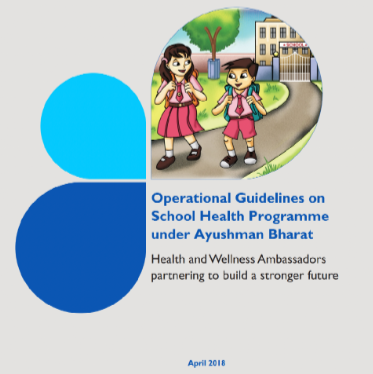
Operational Guidelines on School Health Programme under Ayushman Bharat
Health and well-being are foundations for a country’s development. In order to achieve Suistanable Development Goals 2030, the school health programme associated with Ayushman Bharat and to encourage the stakeholders involved in the school health programme these guidelines were developed to ensure successful and effective learning enviornment and thus improve overall situation of students
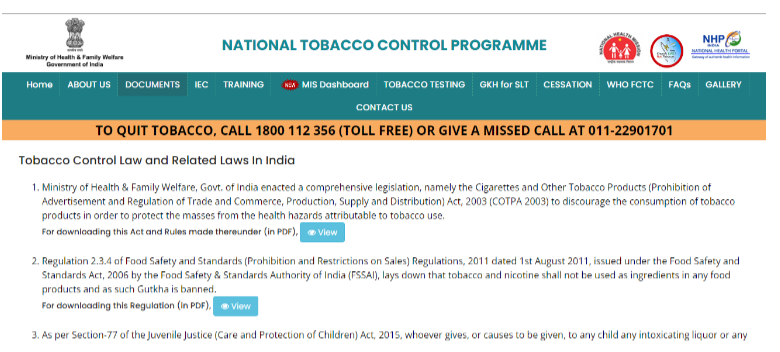
National Tobacco Control Programme
India's National Tobacco Control Programme enforces laws that curb tobacco advertising, regulate its sale, and ban e-cigarettes to safeguard public health. These measures significantly impact mental health by reducing tobacco use, which is associated with anxiety, depression, and other mental health disorders. Protecting youth from tobacco prevents early addiction and its long-term mental health consequences, promoting overall societal well-being.

INTEGRATING MENTAL HEALTH AND PSYCHOSOCIAL SUPPORT INTO YOUTH PROGRAMMING: A TOOLKIT
This Integrating Mental Health and Psychosocial Support into Youth Programming: A Toolkit provides strategies and tools for designing, implementing, and evaluating mental health and psychosocial support (MHPSS) programs and activities for youth in low- and middle-income countries (LMICs) and conflict affected contexts. The Toolkit is a resource for standalone youth MHPSS programs and MHPSS activities that are integrated into cross-sectoral youth-focused programs (e.g., health, gender and gender-based violence or GBV, workforce development/youth employment, education, violence prevention, peace, and stability, etc.).
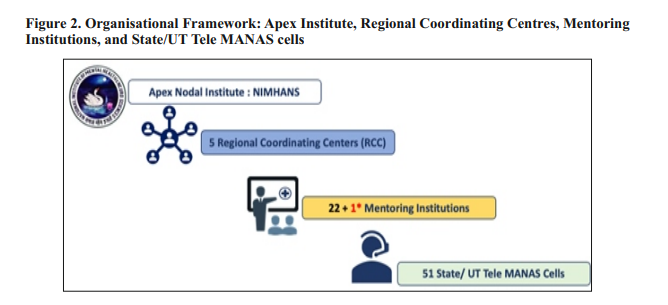
Facilitator’s Manual for Trainers of Tele MANAS Counsellors
The Tele MANAS cells will operate as the functional unit of Tele MANAS at the State/UT level. A total of 51 State/UT Tele MANAS cells will be established, based on the population of the State/UT, following a norm of 1 State cell for every 5-crore population. These cells have been demarcated into two categories.
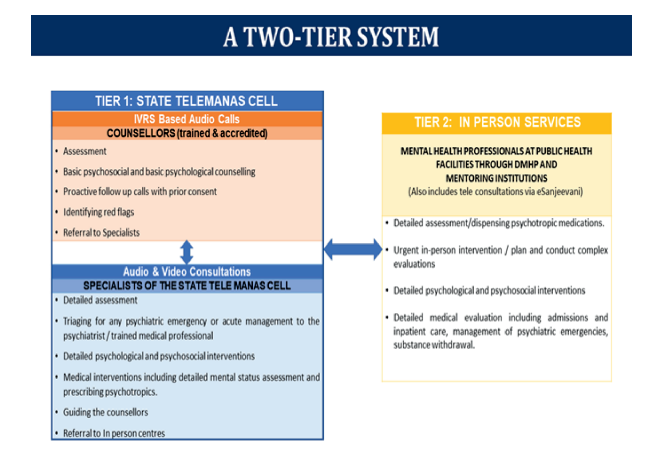
Course Content for Tele MANAS Counsellors
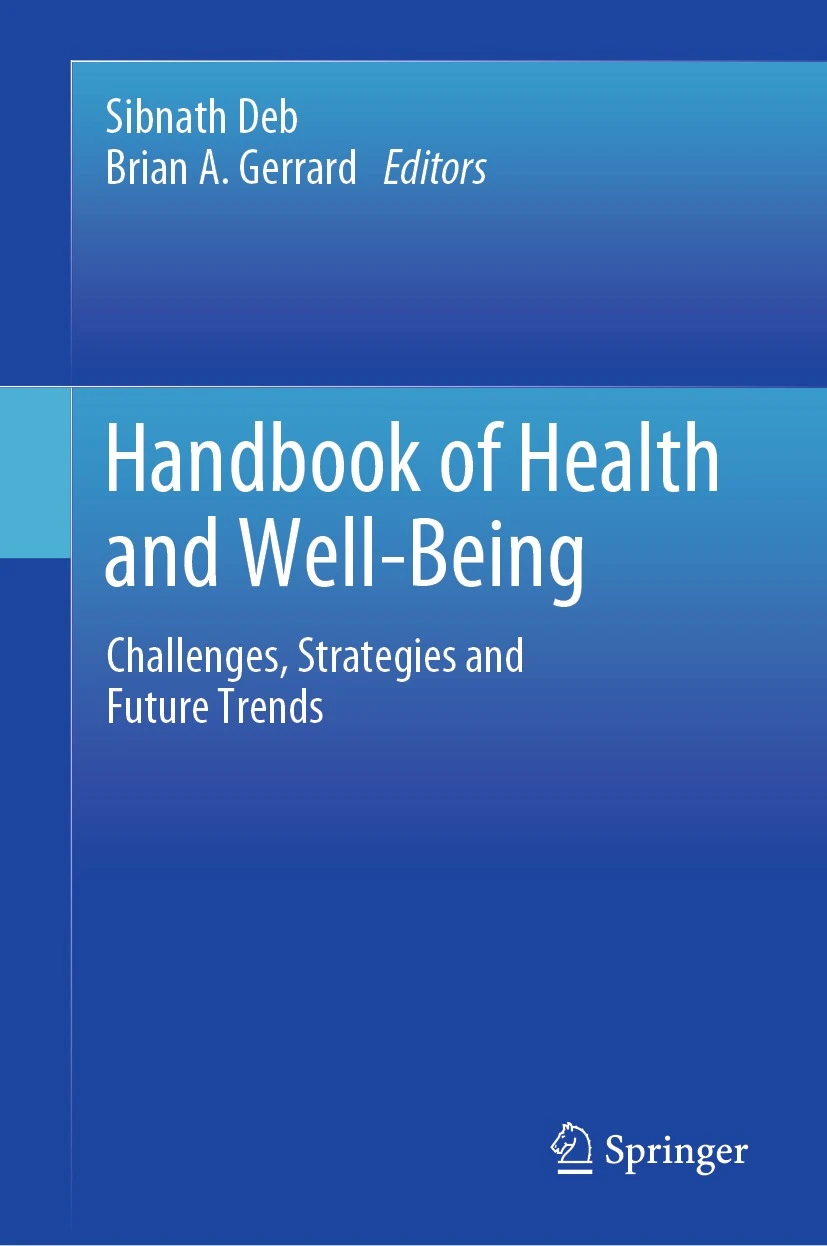
Handbook of Health and Wellbeing
The handbook of health and wellbeing covers contemporary issues related to health and wellbeing from various perspectives on evidence and first-hand experiences. The book discusses future strategies for addressing contemporary and emerging health issues and the overall well-being of the general public, an area not covered in any of the previous volumes.

Wellbeing in Theoretical Context: Theoretical Conceptualization of Wellbeing
This book explains the that well-being consists of three elements that involve the cognitive evaluation of overall satisfaction with life; positive affect; and lower levels of negative affect. Wellbeing can be viewed holistically, in terms of balanced life experience where, wellbeing needs to be considered in relation to how an individual feels and functions across cognitive, emotional, social, physical and spiritual wellbeing.
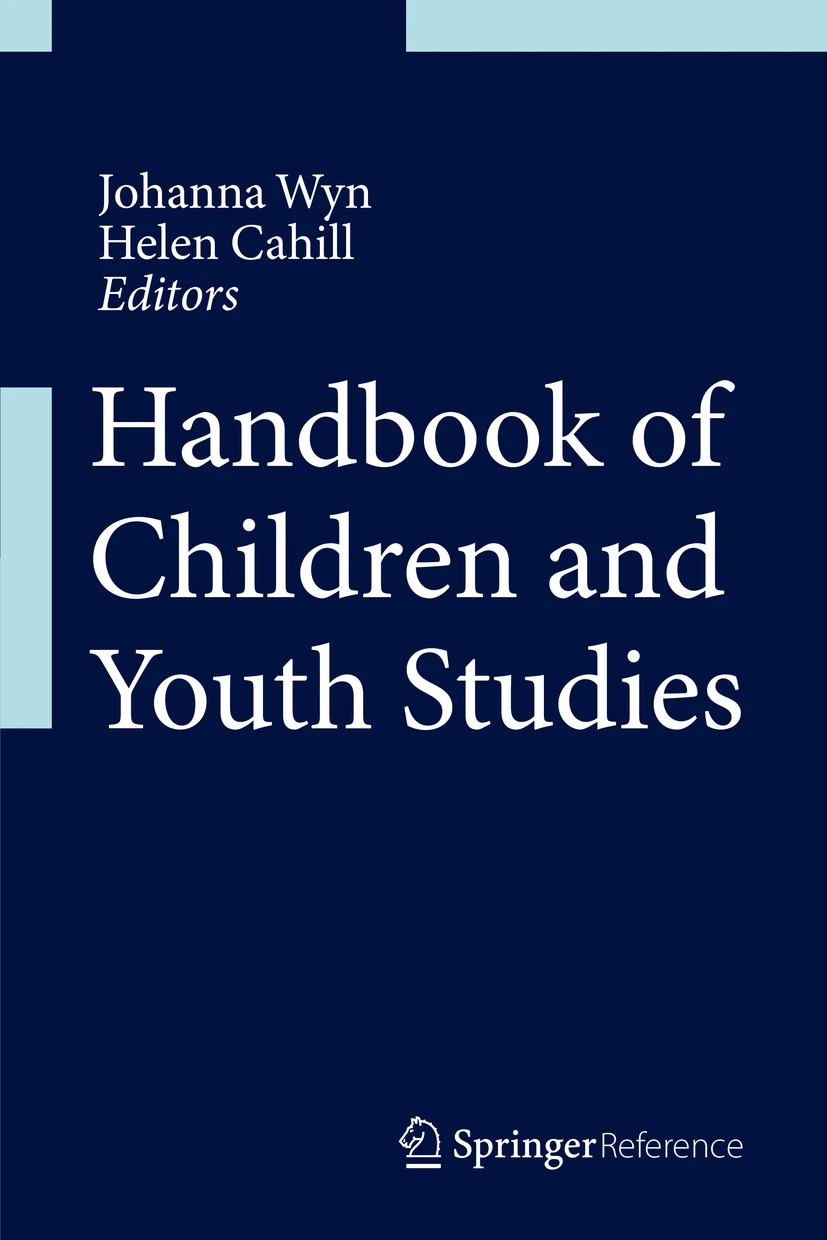
Handbook of Children and Youth Studies
This handbook provides theoretical and methodological key debates and issues that develop and add an understanding of childhood and youth research discipline from a broader perspective. It recognizes the changing social context of the lives of children and young people and address the emerging consensus that the boundaries between childhood, youth and adulthood.
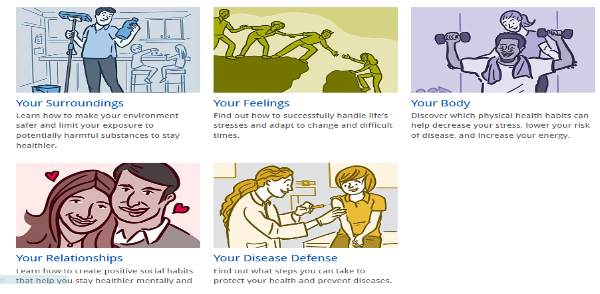
Your Healthiest Self: Wellness Toolkits
The "Your Healthiest Self" wellness toolkits provided by the National Institutes of Health (NIH) offers a collection of wellness toolkits aimed at promoting health and well-being. These toolkits cover a range of topics including physical activity, healthy eating, stress management, sleep hygiene, and mental health. Each toolkit provides evidence-based strategies and resources to help individuals enhance their overall wellness.

Measuring Well-being and Progress: Well-being Research
The OECD Framework for Measuring Well-Being and Progress shown below is based on the recommendations made in 2009 by the Commission on the Measurement of Economic Performance and Social Progress to which the OECD contributed significantly. It also reflects earlier OECD work and various national initiatives in the field. This Framework is built around three distinct components: current well-being, inequalities in well-being outcomes, and resources for future well-being.

Beyond GDP Measureing the value of well-being
Incorporating wellbeing measurement indicators with GDP in policymaking can help the G20 enhance allocative efficiency, as well as provide a comprehensive understanding of the social and economic factors that influence quality of life by appropriately valuing wellbeing. It will help the G20 move towards a more holistic and sustainable approach to economic.

India’s mental health conversation is opening up. Better access to treatment is the next frontier
The study also revealed a dramatic shift in the general perception of people with mental illness with 65% – more than double the 32% from 2018 – believing that such individuals could hold jobs and lead stable, healthy lives. Another 68% maintained that people with mental illness could form meaningful relationships with friends, family and companions, which is a heartening change in a country where the mental health sector is rife with misinformation. Read more….

HAPPINESS AND WELLBEING INDICES
The Global Wellness Institute (GWI) is a 501(c)(3) nonprofit organization with a mission to empower wellness worldwide by educating the public and private sectors about preventative health and wellness. GWI’s research, programs and initiatives have been instrumental in the growth of the USD $4.4 trillion wellness economy—and in uniting the health and wellness industries.Through its five pillars—Research, Initiatives, Roundtable Discussions, wellnessevidence.com and The Wellness Moonshot: A World Free of Preventable Disease—the GWI informs and connects key stakeholders capable of impacting the overall wellbeing of our planet and its citizens.
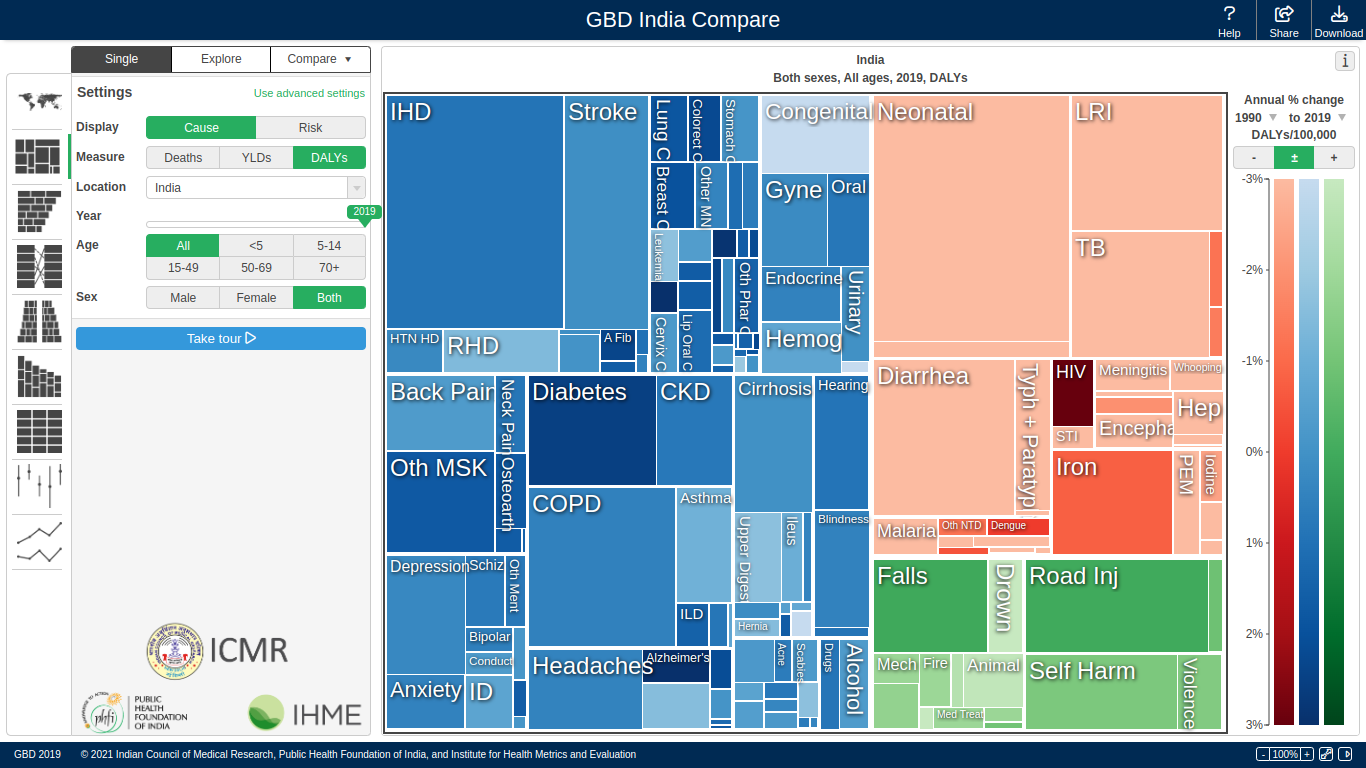
Global Burden of Disease Study 2019 (GBD 2019)

Global Burden of Disease Study 2019 (GBD 2019)

WHO’s World Mental Report
The WHO World Mental Health Report highlights the critical importance of mental health globally, emphasizing the high prevalence of mental health needs and the inadequate responses to these needs. It reveals that nearly a billion people, including 14% of adolescents, live with mental disorders. The report calls for a transformation in mental health care, focusing on reshaping attitudes, improving environments that influence mental health, and strengthening mental health systems. This comprehensive review aims to inspire collective action to enhance mental health support worldwide.

Key Substance Use and Mental Health Indicators in the United States 2022
The 2022 National Survey on Drug Use and Health (NSDUH) highlights the prevalence of mental health and substance use disorders in the United States. It reports significant rates of mental illness, particularly among young adults, and underscores the critical need for accessible mental health services. The survey also discusses the impact of the COVID-19 pandemic on mental health and substance use trends, emphasizing the importance of integrated care and support systems to improve overall well-being.

CDC's Fact Sheet on Mental Health Among Adolescents
The CDC fact sheet on adolescent mental health reveals that a significant number of youth face mental health challenges such as stress, anxiety, and depression, impacting their academic and overall well-being. It emphasizes the need for school-based mental health services and supportive environments to address these issues effectively, advocating for comprehensive approaches to enhance the mental health and well-being of young people.

UNESCO Science Report on Good Health and Well-being (SDG 3)
The UNESCO policy brief on SDG 3 emphasizes the vital role of science in promoting health and well-being. It highlights the critical role of scientific advancements in improving health outcomes and achieving the Sustainable Development Goals. The brief advocates for improved healthcare systems, increased funding for health research, and the use of data-driven policies to enhance public health outcomes globally, particularly in addressing mental health challenges and promoting overall well-being.

A research report on the pursuit of happiness in education
The Delhi SCERT’s research on happiness in education underscores the significance of integrating social and emotional learning into the curriculum. It emphasizes that fostering mindfulness, self-awareness, critical thinking, reflection, and interpersonal relations can greatly
enhance students’ happiness and well-being. This approach is designed to cultivate a more holistic educational experience that supports not only academic success but also personal growth and emotional health.

World Health Statistics 2023: Monitoring Health for SDGs
The World Health Statistics report reviews more than 50 health-related indicators from the Sustainable Development Goals (SDGs) and WHO’s 13th General Programme of work (GPW 13). It discusses the key issues and trends in global health, summary status of the health-related SDGs and GPW 13 indicators and future preparations for the next stage of global health.

Guidelines on Mental Health Promotive and Preventive Interventions for adolescent
The guidelines on promotive and preventive mental health interventions for adolescents- helping adolescents thrive (HAT), provide evidence-informed recommendations on psychosocial interventions to promote mental health, prevent mental disorders ad reduce self-harm and other risk behaviors among adolescents.

What Worked, What Didn’t, What Next
The publication is 2023 progress report provides an overview of what worked, what didn’t and what’s next in the global action plan for healthy lives and wellbeing for all by WHO. It is a comprehensive report that covers various aspects of health care such as primary health care, healthy lifestyle, global health, health priorities, health policy, social determinants of health and community participation.

Bending the Trends to Promote Health and Well-being: A Strategic Foresight on the Future of Health Promotion
This strategic foresight aims to inform future planning of the WHO in support of SDGs and enhanced wellbeing. It provides an analysis of health promotion system capacity models and horizon-scanning of global trends, emphasizing the need for investment in health promotion as a mindset and practice.

How School Systems Can Improve Health and Well-being: Topic Briefs: Nutrition
This topic brief highlights how nutrition and healthy diets support the achievement of education and learning objectives, and explains how intervention benefits can be amplified with a whole-school and systems approach. The recommended actions are informed by the Global Standards for health-promoting schools.

UNICEF and WHO Joint Programme on Mental Health and Psychosocial Well-being and Development of Children and Adolescents
The UNICEF and WHO Joint Programme on Mental Health and Psychosocial Well-being and Development of Children and Adolescents is an ambitious, 10-year action plan to realize a bold vision for children, adolescents, and their caregivers. The joint programme is designed to provide succinct and relevant information on mental health and psychosocial well-being.

World Mental Health Report: Transforming Mental Health for All
The world mental health report highlights the need for change in mental health systems. This report is designed to inspire and inform the indisputable and urgent transformation required to ensure better mental health for all. While promoting a multisectoral approach, this report is especially written for decision-makers in the health sector.

Youth in India 2022
This publication provides diverse profile and status of youth at state and central level for various indicators of socio-economic relevance as derived from published official data for accessing youth statistics by the users, such as education, employment, entrepreneurship, health, sports, social values, community engagement etc.

Sustainable Development and Human Well-Being
The World Happiness Report is a publication of the Sustainable Development Solutions Network, powered by the Gallup World Poll data. The World Happiness Report reflects a worldwide demand for more attention to happiness and well-being as criteria for government policy. It reviews the state of happiness in the world today and shows how the science of happiness Read more…

HAPPINESS AND WELLBEING INDICES
The Global Wellness Institute (GWI) is a 501(c)(3) nonprofit organization with a mission to empower wellness worldwide by educating the public and private sectors about preventative health and wellness. GWI’s research, programs and initiatives have been instrumental in the growth of the USD $4.4 trillion wellness economy—and in uniting the health and wellness industries.Through its five pillars—Research, Initiatives, Roundtable Discussions, wellnessevidence.com and The Wellness Moonshot: A World Free of Preventable Disease—the GWI informs and connects key stakeholders capable of impacting the overall wellbeing of our planet and its citizens.

India’s mental health conversation is opening up. Better access to treatment is the next frontier
The study also revealed a dramatic shift in the general perception of people with mental illness with 65% – more than double the 32% from 2018 – believing that such individuals could hold jobs and lead stable, healthy lives. Another 68% maintained that people with mental illness could form meaningful relationships with friends, family and companions, which is a heartening change in a country where the mental health sector is rife with misinformation. Read more….

Beyond GDP Measureing the value of well-being
Incorporating wellbeing measurement indicators with GDP in policymaking can help the G20 enhance allocative efficiency, as well as provide a comprehensive understanding of the social and economic factors that influence quality of life by appropriately valuing wellbeing. It will help the G20 move towards a more holistic and sustainable approach to economic.

Happiness Council
Governments can help citizens with treatment and strategy through policies and help deliver options to all population levels, including the vulnerable. Technology also has a crucial role in improving resilience, but only when cooperating with organizations, regulations, structures, and other stakeholders. The briefs explore vulnerabilities and sources of

Measuring Well-being and Progress: Well-being Research
The OECD Framework for Measuring Well-Being and Progress shown below is based on the recommendations made in 2009 by the Commission on the Measurement of Economic Performance and Social Progress to which the OECD contributed significantly. It also reflects earlier OECD work and various national initiatives in the field. This Framework is built around three distinct components: current well-being, inequalities in well-being outcomes, and resources for future well-being.

Your Healthiest Self: Wellness Toolkits
The "Your Healthiest Self" wellness toolkits provided by the National Institutes of Health (NIH) offers a collection of wellness toolkits aimed at promoting health and well-being. These toolkits cover a range of topics including physical activity, healthy eating, stress management, sleep hygiene, and mental health. Each toolkit provides evidence-based strategies and resources to help individuals enhance their overall wellness.

Handbook of Children and Youth Studies
This handbook provides theoretical and methodological key debates and issues that develop and add an understanding of childhood and youth research discipline from a broader perspective. It recognizes the changing social context of the lives of children and young people and address the emerging consensus that the boundaries between childhood, youth and adulthood.

Wellbeing in Theoretical Context: Theoretical Conceptualization of Wellbeing
This book explains the that well-being consists of three elements that involve the cognitive evaluation of overall satisfaction with life; positive affect; and lower levels of negative affect. Wellbeing can be viewed holistically, in terms of balanced life experience where, wellbeing needs to be considered in relation to how an individual feels and functions across cognitive, emotional, social, physical and spiritual wellbeing.

Handbook of Health and Wellbeing
The handbook of health and wellbeing covers contemporary issues related to health and wellbeing from various perspectives on evidence and first-hand experiences. The book discusses future strategies for addressing contemporary and emerging health issues and the overall well-being of the general public, an area not covered in any of the previous volumes.

Course Content for Tele MANAS Counsellors

Facilitator’s Manual for Trainers of Tele MANAS Counsellors
The Tele MANAS cells will operate as the functional unit of Tele MANAS at the State/UT level. A total of 51 State/UT Tele MANAS cells will be established, based on the population of the State/UT, following a norm of 1 State cell for every 5-crore population. These cells have been demarcated into two categories.

INTEGRATING MENTAL HEALTH AND PSYCHOSOCIAL SUPPORT INTO YOUTH PROGRAMMING: A TOOLKIT
This Integrating Mental Health and Psychosocial Support into Youth Programming: A Toolkit provides strategies and tools for designing, implementing, and evaluating mental health and psychosocial support (MHPSS) programs and activities for youth in low- and middle-income countries (LMICs) and conflict affected contexts. The Toolkit is a resource for standalone youth MHPSS programs and MHPSS activities that are integrated into cross-sectoral youth-focused programs (e.g., health, gender and gender-based violence or GBV, workforce development/youth employment, education, violence prevention, peace, and stability, etc.).

Global Burden of Disease Study 2019 (GBD 2019)

National Tobacco Control Programme
India's National Tobacco Control Programme enforces laws that curb tobacco advertising, regulate its sale, and ban e-cigarettes to safeguard public health. These measures significantly impact mental health by reducing tobacco use, which is associated with anxiety, depression, and other mental health disorders. Protecting youth from tobacco prevents early addiction and its long-term mental health consequences, promoting overall societal well-being.

Operational Guidelines on School Health Programme under Ayushman Bharat
Health and well-being are foundations for a country’s development. In order to achieve Suistanable Development Goals 2030, the school health programme associated with Ayushman Bharat and to encourage the stakeholders involved in the school health programme these guidelines were developed to ensure successful and effective learning enviornment and thus improve overall situation of students

India Road Assessment Programme (IndiaRAP)
IndiaRAP works to enhance road safety in India, significantly contributing to health and well-being by reducing accidents and fatalities. Through systematic safety assessments, implementing safer road designs, and training professionals, IndiaRAP aims to create safer travel environments. This effort not only saves lives but also enhances the overall quality of life by reducing the mental health burden caused by traffic-related injuries and deaths.

NATIONAL MENTAL HEALTH PROGRAMME (NMHP)
From a public health perspective, the prevalence, pattern, characteristics and determinants of various mental disorders have been examined. In addition, care related issues like service delivery aspects and system issues have also been studied.
In this emerging scenario, mental, neurological and substance use disorders (MNSUDs), included under the broader rubric of NCDs are well acknowledged as major public health problems with a greater share of morbidity and disability.

Aligning AI Optimization to Community Well-Being
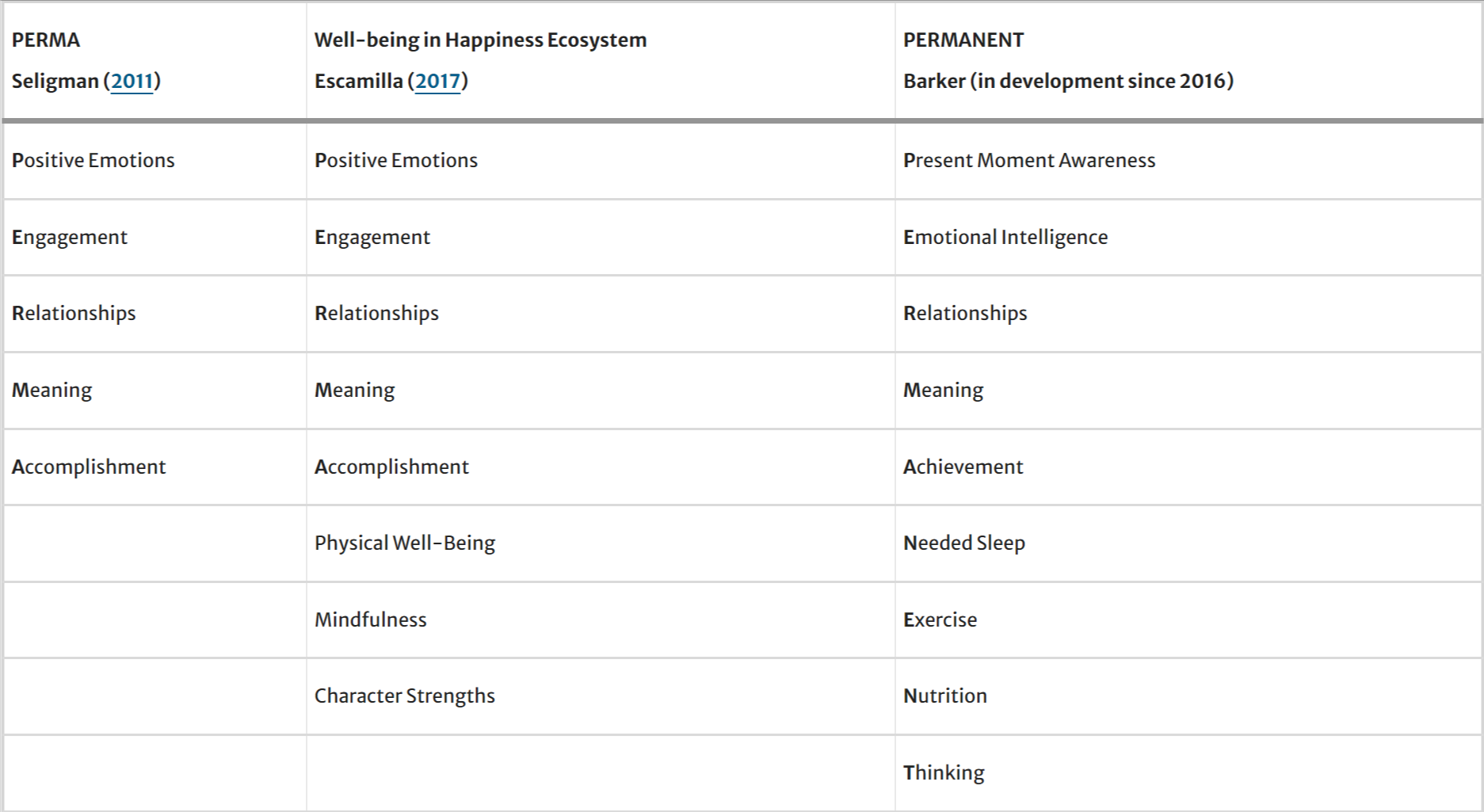
Enhancing Mindfulness and Well-Being in Higher Education
The process and rationale for creating and adopting the PERMANENT Model of Well-Being is also provided. Comparisons are made regarding the similarities and differences between the PERMANENT Model and two existing models: the PERMA Model and the Universidad Tecmilenio Well-being in Happiness Ecosystem.
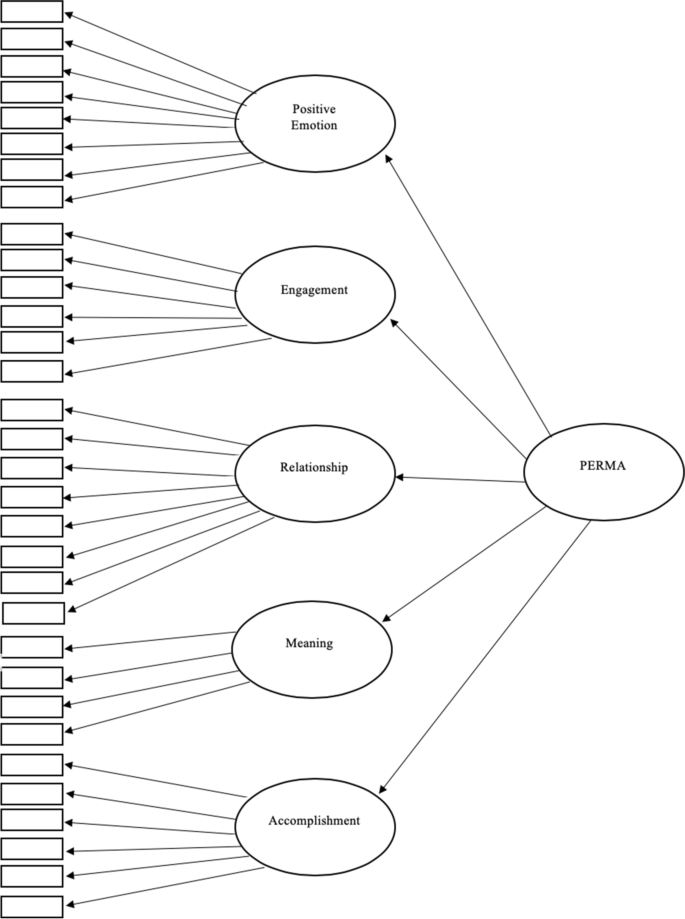
Application of the PERMA Model of Well-being in Undergraduate Students
The PERMA model was introduced by Seligman in 2011 to increase and measure well-being. This model defines well-being in terms of Positive Emotion, Engagement, Relationships, Meaning, and Accomplishment (PERMA). The purpose of this study was to test whether all five PERMA elements of well-being could be constructed from items within the 2018 Purdue University Student Experience at a Research University (SERU) survey.
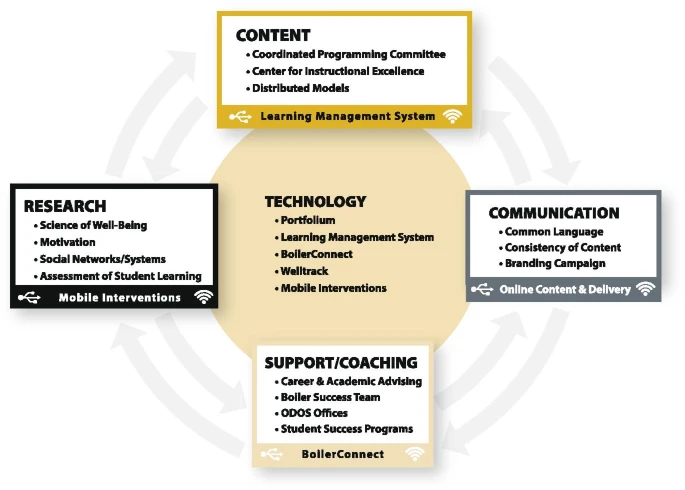
A holistic approach to campus well-being: Steps to Leaps at Purdue University
In response to the increasing demand of mental health solutions, Purdue University launched the Steps to Leaps initiative in 2019 to promote student well-being. It provided the tools and resources to build students’ resilience skills and establish lifelong habits to help them realize their personal definitions of success. Working collaboratively with students.

What Kind of Community Development System Can Effectively Support Citywide Philanthropic Efforts to Promote Community Well-Being?
This article uses a citywide, engagement-driven initiative led by local practitioners that took place in Detroit between 2016 and 2019. This article is based on the initiative’s two main outcomes, namely the identification of seven elements of an effective community development system and a vitality framework designed to measure community progress and success.
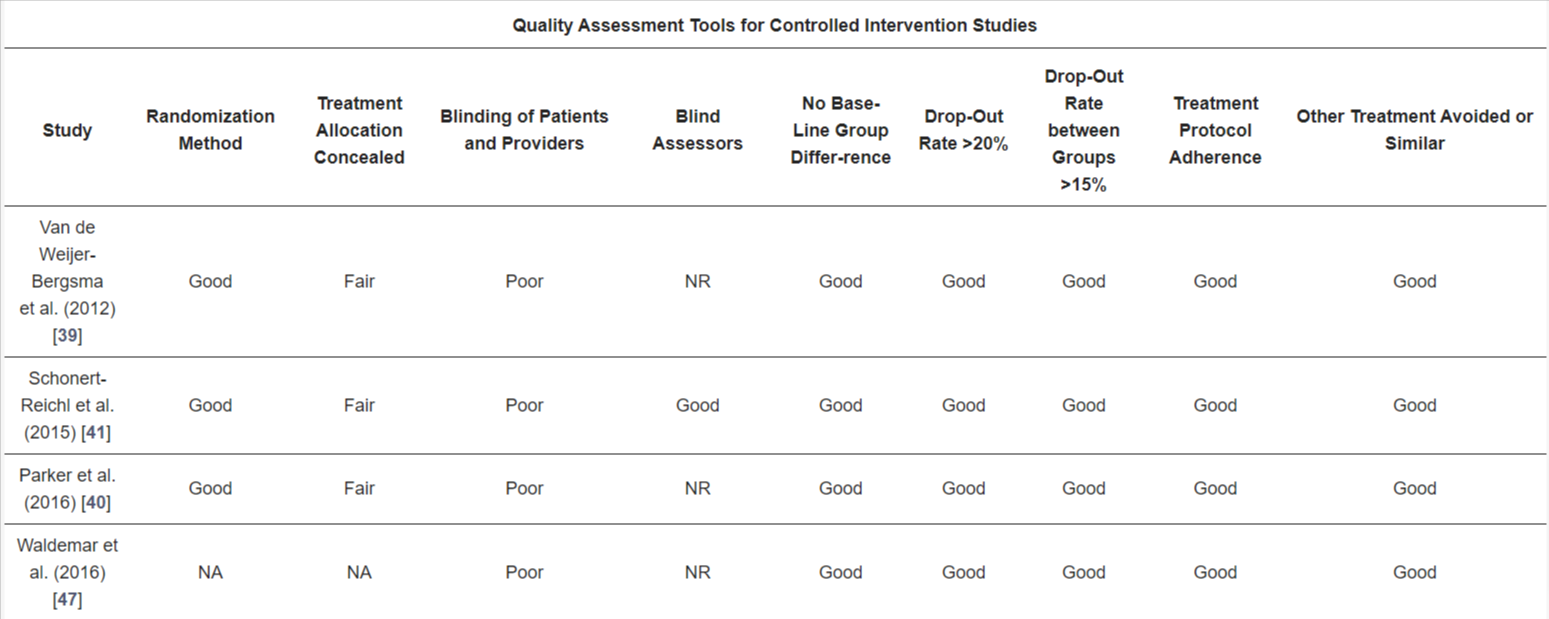
School Mindfulness-Based Interventions for Youth, and Considerations for Anxiety, Depression, and a Positive School Climate—A Systematic Literature Review
The results show discrepancies in terms of methodological and implementation variables, types of interventions, instructor trainings, assessment measures, and choice of practices and exercises, which make the effects of existing school MBIs difficult to compare. Consistencies were observed in emotional and behavioral regulation, prosocial behaviors, and reducing stress and anxiety in students.

Optimising adolescent wellbeing in a digital age
Today’s adolescents are transitioning from childhood to adulthood in an era of rapid digitalisation. Digital media—such as online communication platforms and applications accessed through mobile phones, tablets, and computers—are an important window into the world for adolescents. Optimise adolescent wellbeing in this digital age, adolescents must be equipped and empowered to use digital media in ways that foster their immediate and future wellbeing. However, the burden of managing the risks of poorly regulated digital environments cannot be placed entirely on adolescents and their caregivers. Governance mechanisms and services for adolescents—including health services—must also be strengthened to provide the necessary support and protection to young users.

What Is Next for Public Health after COVID-19 in Italy? Adopting a Youth-Centred Care Approach in Mental Health Services
The Italian National Action Plan for Mental Health reports a highly fragmented situation in the Child and Adolescent Neuropsychiatry services, in terms of an integrated and comprehensive regional network of services for the diagnosis, treatment, and rehabilitation of neuropsychological disorders in young people.

Interventions to improve well-being among children and youth aged 6-17 years during the COVID-19 pandemic: a systematic review
Studies deploying synchronous interventions most often reported improved well-being among children and youth largely in the domain of health and nutrition, specifically physical and mental health. Targeted approaches will be crucial to reach sub-groups of children and youth who are most at risk of negative well-being outcomes. Further research is needed.
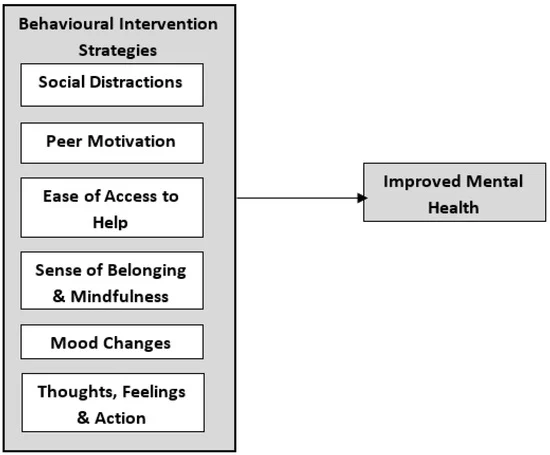
Awareness of Behavioural Intervention Strategies in Curbing Mental Health Issues among Youth in Malaysia
A total of 103 respondents between the ages of 18 to 23 years participated in the research survey, and the results revealed that mood changes and thoughts, feelings, and actions were the intervention strategies that showed a positive significance in the improvement of mental health among youth in Malaysia. Social distractions, peer motivation, ease of access to help, and sense of belonging and mindfulness did not show a positive significance when it came to behavioural intervention technologies used to improve mental health.
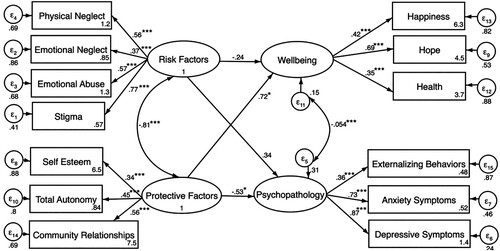
Risk and protective factors for mental health and wellbeing among adolescent orphans

Daily experiences and adolescent affective wellbeing during the COVID-19 pandemic: The CHESS model
The COVID-19 pandemic resulted in adolescents’ increased exposure to daily experiences of risk factors for depression and anxiety (e.g., loneliness). Intensive longitudinal studies examining daily experiences during the pandemic have revealed short-term and long-term consequences on youth mental health.
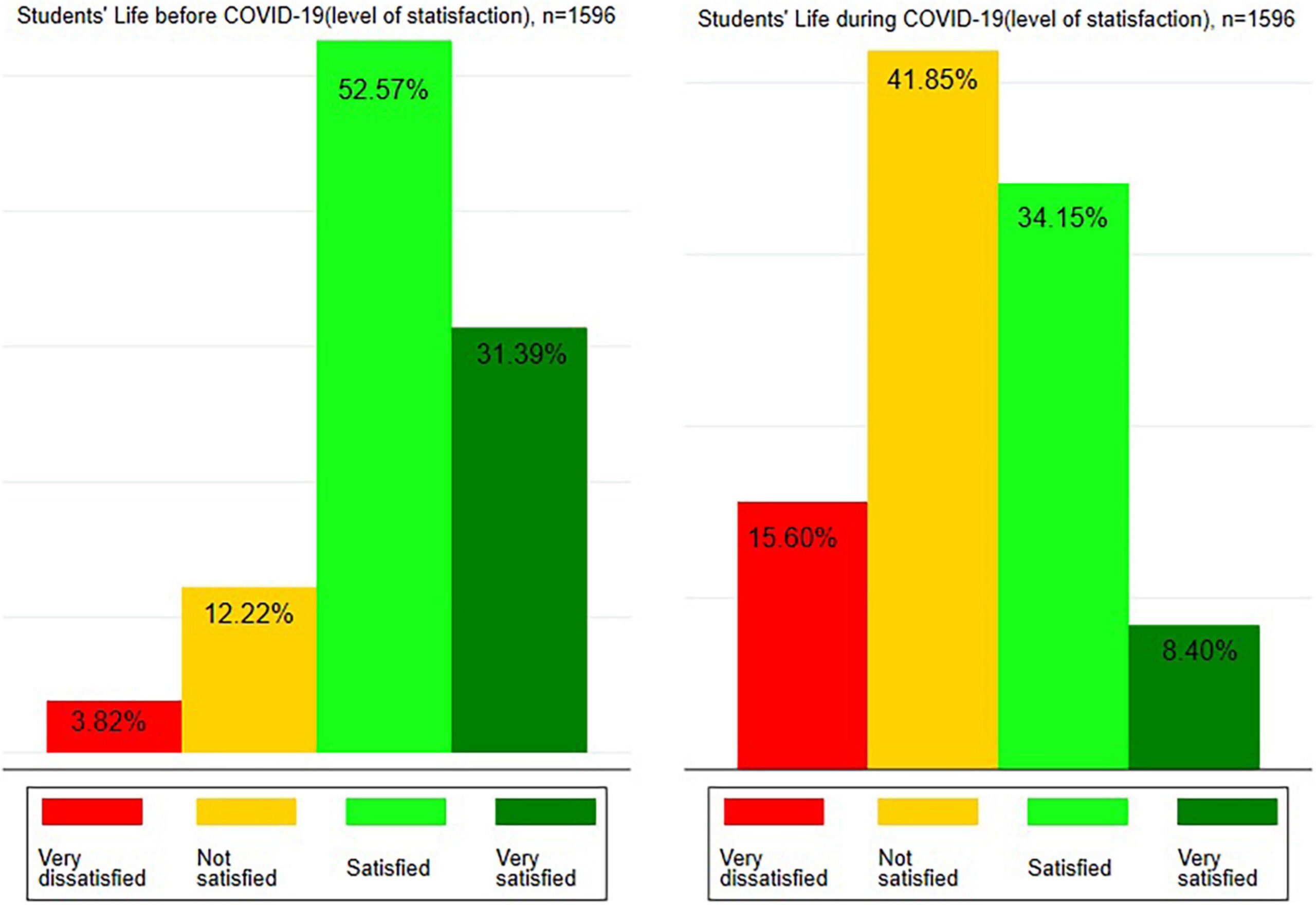
Impact of closure of educational institutions due to COVID-19 lockdown on overall subjective wellbeing of adolescents and youth: Cross-sectional survey, India
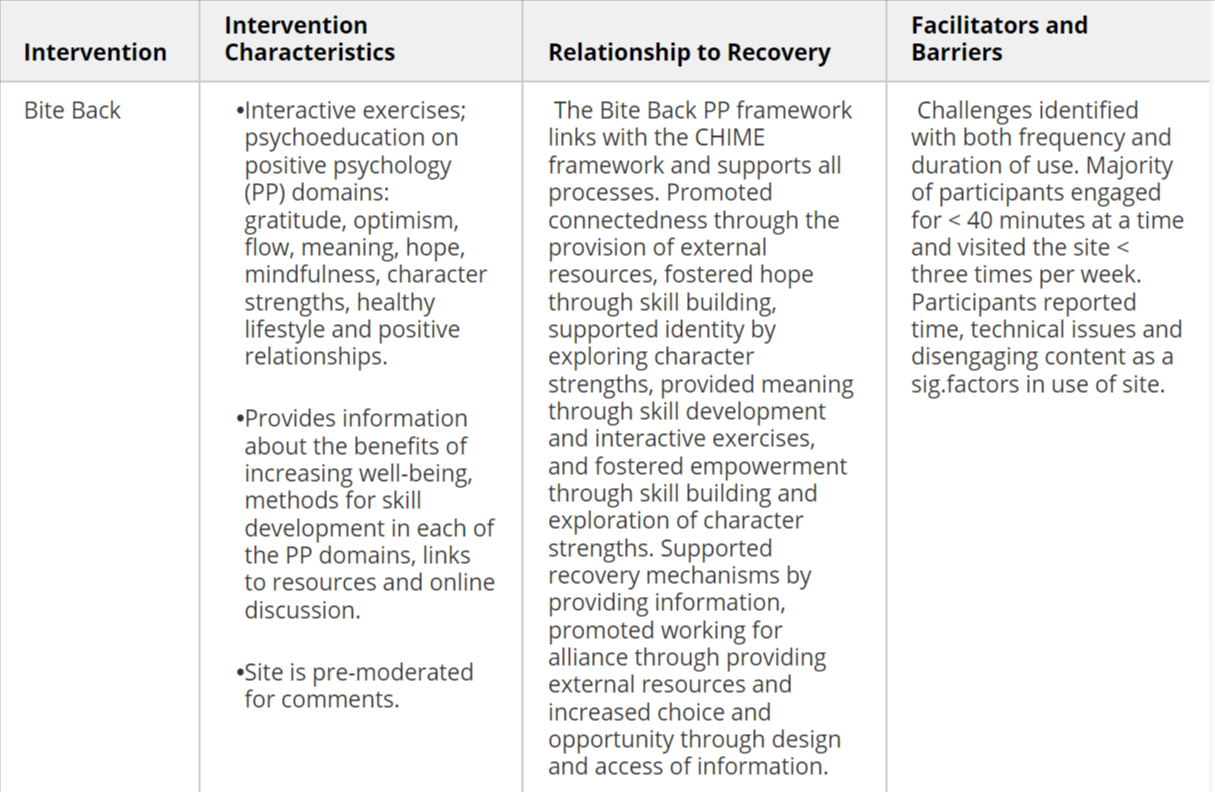
Internet-based interventions to support recovery in youth: A systematic review
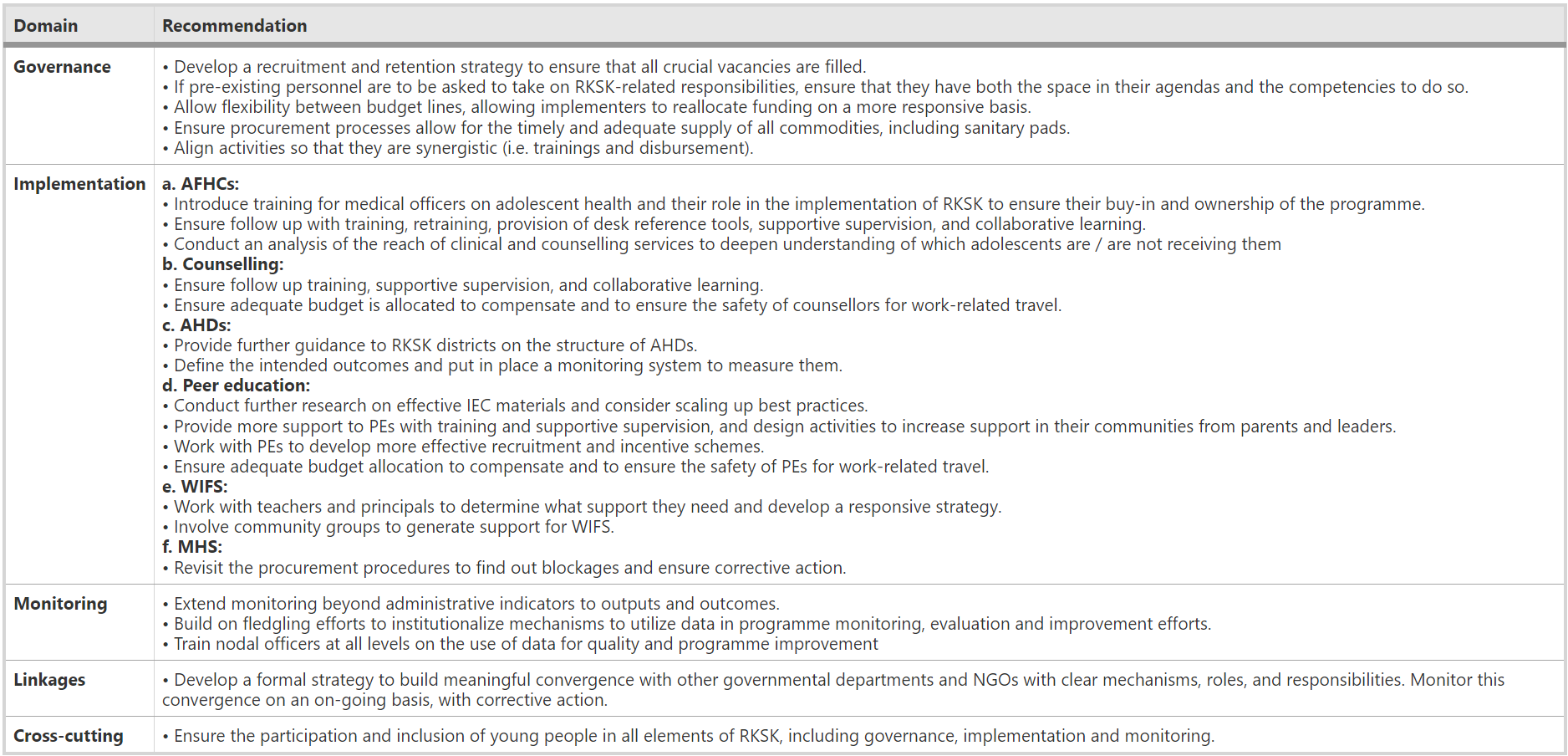
Adolescent health programming in India: a rapid review
In 2016, in response to a request from the Government of India, the World Health Organisation undertook a rapid programme review of ARSH and RKSK at the national level and in four states (Haryana, Madhya Pradesh, Maharashtra and Uttarakhand) to identify and document lessons learnt in relation to four domains of the programmes (governance, implementation, monitoring and linkages) that could be used to enhance current and future adolescent health programming in India.

Mindfulness-based programmes to reduce stress and enhance well-being at work: a realist review
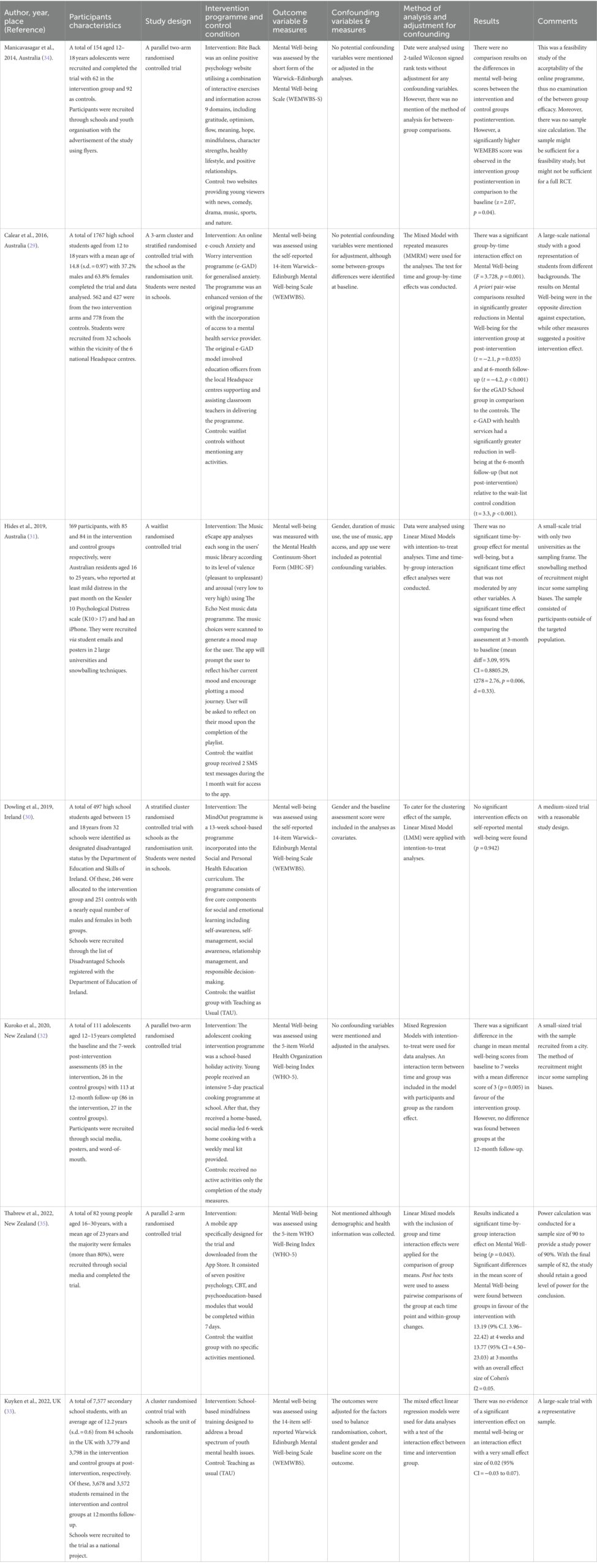
Child and adolescent mental well-being intervention programme: A systematic review of randomised controlled trials
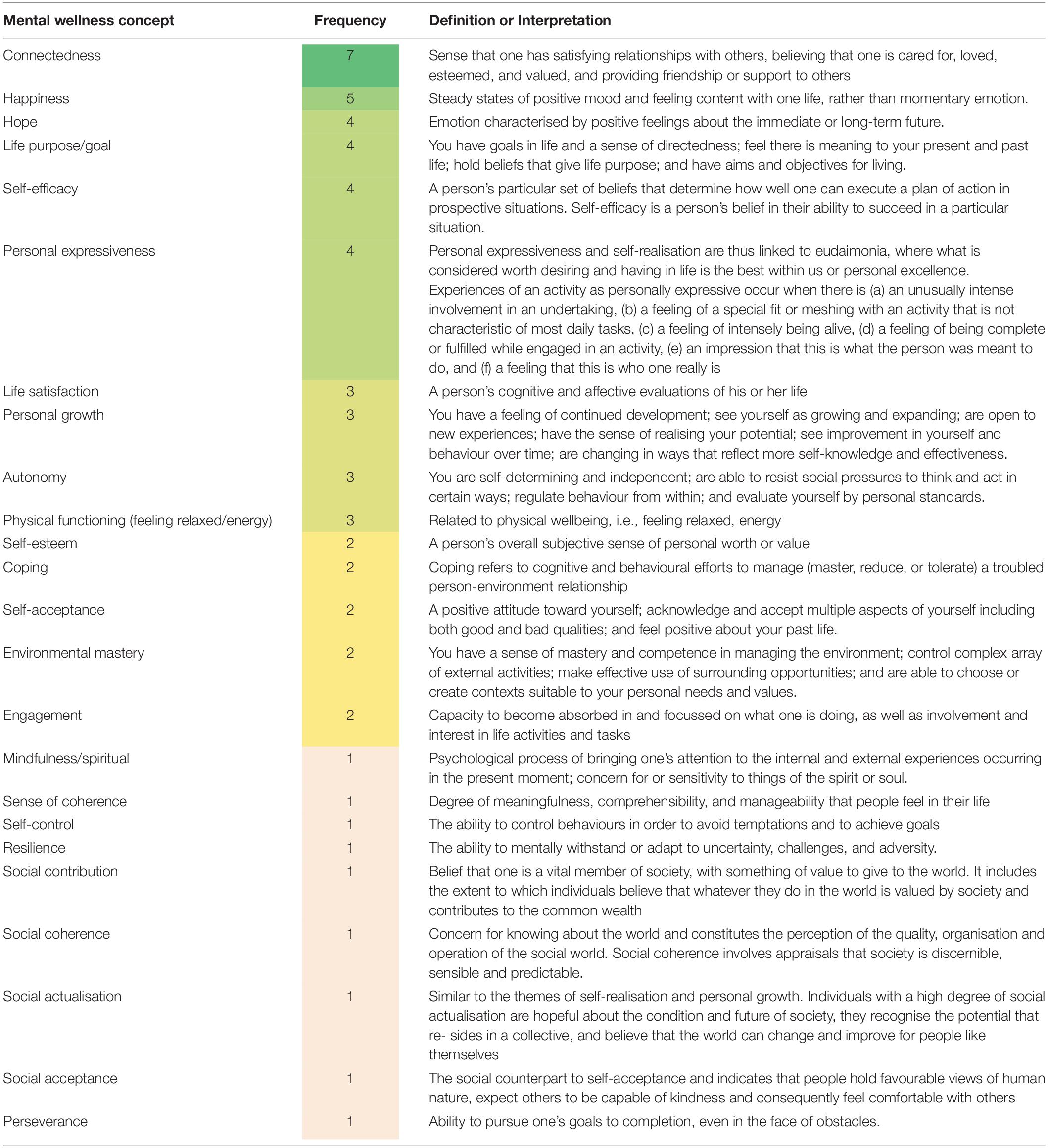
Measuring Mental Wellness of Adolescents: A Systematic Review of Instruments
Mental health is critical to the healthy development of adolescents. However, mental health encompasses more than the absence of mental illness; and should include indicators of mental wellness. A critical review of available mental wellness instruments for adolescents were conducted to identify operational definitions of mental wellness concepts for this population group.

Multi-sectoral action to promote psychological wellbeing: Theorising the role of place-based policy
Several national governments are showing interest in policies to promote wellbeing. One common strategy is to devise systems to measure indictors of wellbeing, presuming that governments act on what they measure. This article will argue instead that formation of multisectoral policies to promote psychological wellbeing requires a different kind of theoretical and evidentiary basis.Place-based policy is foundational for effective multi-sectoral policy to promote psychological wellbeing.
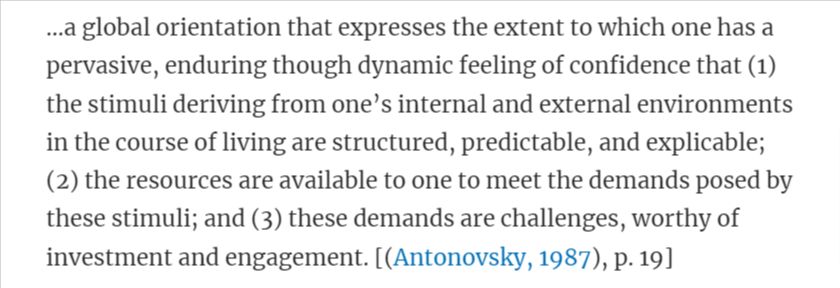
Wellbeing as a policy framework for health promotion and sustainable development
This paper examines key health promotion concepts and approaches, juxtaposed with philosophical underpinnings of the concept of wellbeing, alternative measurement strategies, and examples of wellbeing policy initiatives. In doing so, the paper highlights the relevance of wellbeing policy frameworks to health promotion, the utility of health promotion strategies for implementing wellbeing policy frameworks, and controversies and pitfalls that require consideration.
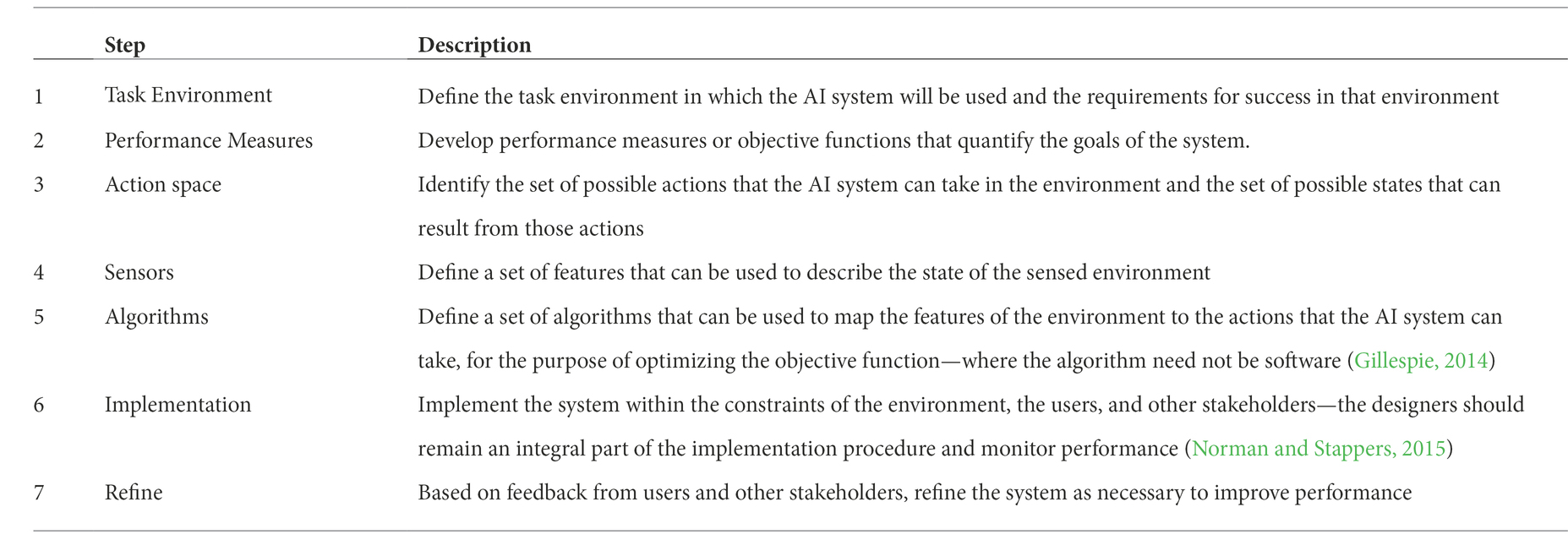
A framework for designing AI systems that support community wellbeing
Designing artificial intelligence (AI) to support health and wellbeing is an important and broad challenge for technologists, designers, and policymakers. Drawing upon theories of AI and cybernetics, this article offers a design framework for designing intelligent systems to optimize human wellbeing.
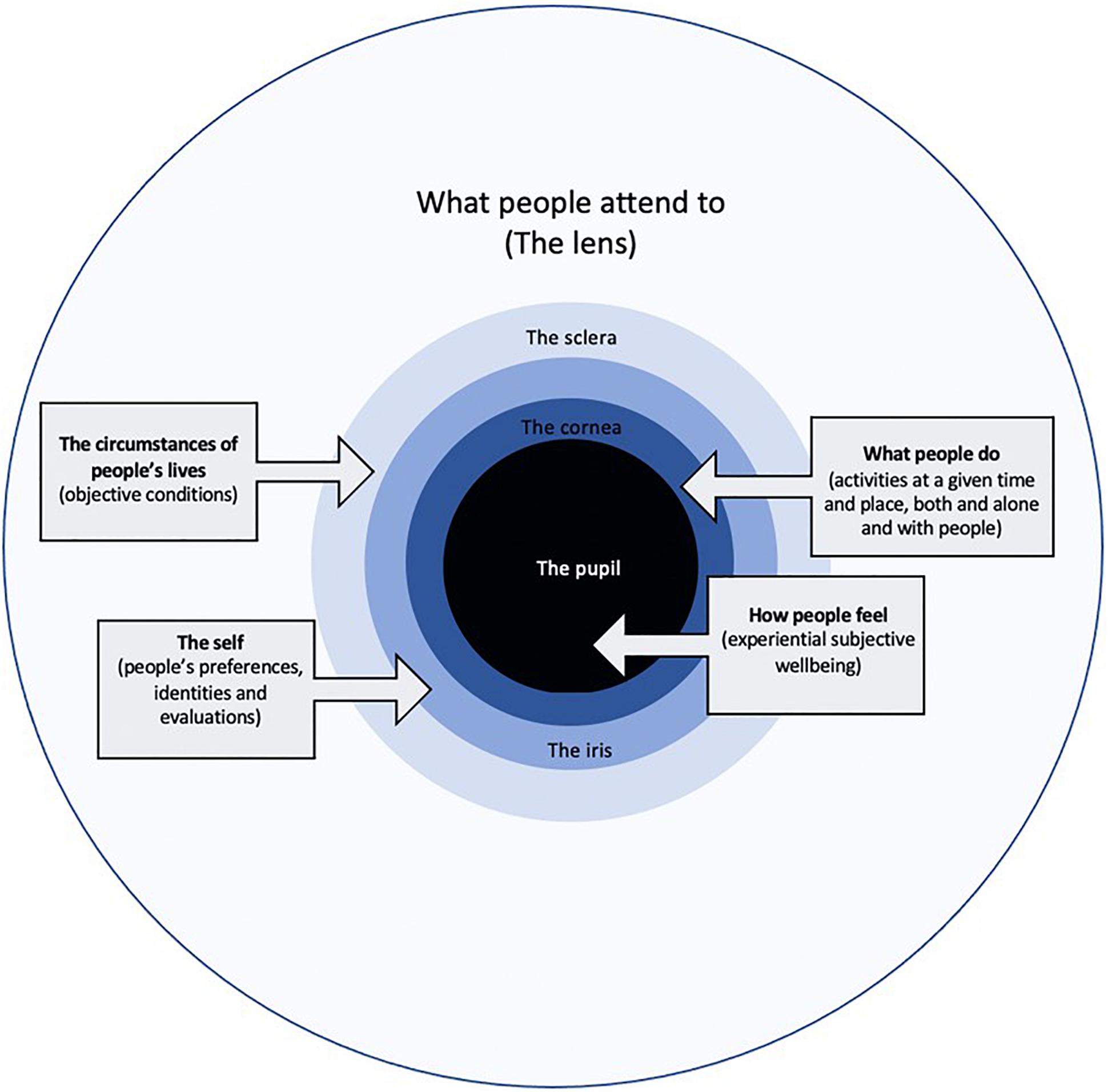
The Welleye: A Conceptual Framework for Understanding and Promoting Wellbeing
We present the Welleye – a novel and conceptually clear framework that shows how attention links the objective circumstances of people’s lives and selves to how they spend their time and feel day to day. While existing wellbeing frameworks in policy contain many of the factors included in the Welleye, they all lack attention as the “lens” that determines the impact of these factors on how people feel. Policymakers and organizations can use the Welleye to better understand how people are faring and design and evaluate interventions aimed at making people better off.

Prioritizing the Mental Health and Well-Being of Healthcare Workers: An Urgent Global Public Health Priority
The COVID-19 pandemic has had an unprecedented impact on health systems in most countries, and in particular, on the mental health and well-being of health workers on the frontlines of pandemic response efforts. The purpose of this article is to provide an evidence-based overview of the adverse mental health impacts on healthcare workers during times of crisis and other challenging working conditions and to highlight the importance of prioritizing and protecting the mental health and well-being of the healthcare workforce, particularly in the context of the COVID-19 pandemic. First, we provide a broad overview of the elevated risk of stress, burnout, moral injury, depression, trauma, and other mental health challenges among healthcare workers. Second, we consider how public health emergencies exacerbate these concerns, as reflected in emerging research on the negative mental health impacts of the COVID-19 pandemic on healthcare workers.

A correlational study between perceived parenting style, psychological well-being, and emotional intelligence among adolescents
Background: In many reviews, it is found that parental responsiveness, parental emotion-related coaching, and parental positive demandingness are related to children’s higher emotional intelligence (EI), while parental negative demandingness is related to children’s lower EI. There is a lack of Indian work in this area.
Aim: To study the role of EI and parenting style in predicting psychological well-being among adolescents in an Indian scenario.

Telework satisfaction, wellbeing and performance in the digital era. Lessons learned during COVID‑19 lockdown in Spain
Abstract: This study used a prospective design to examine the efects of telework satisfaction (time 1) on subjective wellbeing and self-reported performance (time 2) during the COVID-19 lockdown. Data were collected from 111 teleworkers through an online survey the frst weeks of strict lockdown in Spain. Telework satisfaction showed positive direct efects on both subjective wellbeing and self-reported performance.

The relationship between self-care, positive family environment, and human wellbeing
Self-care behaviors are fundamental for a healthy lifestyle. These behaviors can lead to improved physical and psychological health, which can in turn lead to individual and social wellbeing. The present paper proposes self-care as a set of behaviors that help sustain a positive environment (i.e., a sustainable behavior) wherein individuals who take care of themselves can aid in maintaining the positivity of the environment.
One out of seven in 15-24 years of age feels depressed in India: UNICEF
A UNICEF report reveals that 14% of India’s youth (15-24 years) are battling depression, exacerbated by the COVID-19 pandemic’s toll on mental health. The shift from extended to nuclear families is contributing to this rise. Highlighting the crisis, the Union Health Minister calls for integrating mental health education, affirming the interdependence of mental and physical well-being.
Report on Physical, mental well being top priorities for Indians in 2024
In 2024, Indians are prioritizing physical and mental well-being alongside financial management. A survey revealed that 76% prioritize physical health and 69% personal finance. The key health goals include healthier eating and more outdoor activities. Additionally, 80% are looking for a better work-life balance and flexible work arrangements. Sustainable practices, such as reducing plastic use, are also important to them.
Mental health in a post-Covid world: Who’s still struggling in India?
A survey of over 46,982 Indians showed that 30.4% are grappling with mental health issues post-COVID-19, higher than the global average of 27.1%. Younger individuals, especially those under 35, are the most affected, with significant declines in well-being linked to early smartphone use and processed food intake. Women and less-educated individuals report higher distress levels. The pandemic's impact on mental health persists, highlighting the need for ongoing support and intervention.
Health Officials focus on mental health access as depression and suicide rates remain high
Mental health access remains a critical concern as depression and suicide rates continue to be high. Ohio’s health officials are actively working to enhance mental health service availability, especially for young people and adults. The state continues to face a steady number of suicides, but there is a silver lining as overdose deaths show signs of decline. Initiatives like the Great Minds Fellowship are being launched to increase the number of behavioral health professionals.
Science of Happiness course introduced in Delhi University
Delhi University has introduced a new course titled ‘Science of Happiness’, aimed at enhancing the well-being of students. This innovative program is designed to teach students about the psychological and physiological aspects of happiness. The course will be integrated into the university’s curriculum, initially as an optional subject, with the potential to become a major or minor subject in the future. The Rekhi Foundation will be responsible for developing the curriculum and training faculty members to deliver it effectively. This initiative underscores the university’s commitment to fostering a positive learning environment and prioritizing student happiness.
others :- Measuring Well-being and Progress: Well-being Research
Beyond GDP Measureing the value of well-being
India’s mental health conversation is opening up. Better access to treatment is the next frontier
HAPPINESS AND WELLBEING INDICES

Happiness Council
Governments can help citizens with treatment and strategy through policies and help deliver options to all population levels, including the vulnerable. Technology also has a crucial role in improving resilience, but only when cooperating with organizations, regulations, structures, and other stakeholders. The briefs explore vulnerabilities and sources of

India’s response to adolescent mental health: a policy review and stakeholder analysis
There is no conformity of the age ranges addressed by these documents nor are vulnerable groups explicitly recognized. Stress, anxiety and depression were commonly identified as mental health concerns and diverse platforms such as community, family, school, digital and health facility were recommended to deliver preventive and treatment interventions. Some interventions specifically targeted some social determinants (like safe and supportive schools) but many others (like social norms) were not addressed.

Sustainable Development and Human Well-Being
The World Happiness Report is a publication of the Sustainable Development Solutions Network, powered by the Gallup World Poll data. The World Happiness Report reflects a worldwide demand for more attention to happiness and well-being as criteria for government policy. It reviews the state of happiness in the world today and shows how the science of happiness Read more…

